Global News: BC advocates raising alarm due to recent clear-cut on Vancouver Island
July 6, 2024
Global News
An old growth advocate group is raising concerns regarding a recent clear-cut on Vancouver Island. Paul Johnson has more.
July 6, 2024
Global News
An old growth advocate group is raising concerns regarding a recent clear-cut on Vancouver Island. Paul Johnson has more.
July 3, 2024
By: Curtis Blandy
Victoria Buzz
Original article here.
BC old-growth activists have taken before and after photos of a large area of an ancient grove that was clear-cut on Vancouver Island near Port Alberni in the Nahmint Valley.
The Ancient Forest Alliance says that many of the massive trees that were cut down were over 500 years old, some being up to nine feet across.
Now that the grove has been cut, they are urging the BC government to immediately correct misidentified at-risk old-growth forests that could be eligible for logging deferrals.
The Nahmint Valley clear-cut spans 17.4 hectares, roughly 31 football fields, and contains numerous giant, old-growth trees. Some of the trees lost to this clearcut were immense redcedars and rare, old-growth Douglas-fir trees.
The Ancient Forest Alliance also says that an at-risk species, specklebelly lichen, was recently documented in the area and this particular lichen can only be found in old-growth groves.
The old-growth advocates added that BC Timber Sales (BCTS), the BC government’s own logging agency, owned and auctioned off this forest to the highest bidder.
They say that as of this publication, trees are still being felled.
The Ancient Forest Alliance says this area should have never been logged and should have been a part of the millions of hectares protected by deferrals because it was originally identified as an at-risk old-growth forest.
“When I first visited this endangered forest several months ago, I was amazed by its sheer beauty. It was filled with massive old-growth trees, gardens of ferns and wildflowers carpeted the forest floor, and birdsong filled the air. It was like stepping into a lost world,” recounted TJ Watt, campaigner & photographer with the Ancient Forest Alliance.
“When we returned last week, it was old-growth carnage. The shattered bodies of ancient cedars lie where a vibrant and biodiverse ecosystem once stood.”
Watt added that Premier Eby has said he intends to move forward and protect old-growth forests in BC, but there is more that can be done.
Ancient Forest Alliance is calling on Eby to direct BC Timber Sales to lead by example and put an end to clearcutting old-growth.
The BC government has significantly ramped up their efforts to protect these at-risk areas over the past year. These efforts include a commitment to protect 30% of the province’s old-growth by 2030 and allocating significant funding for this endeavour.
What the Ancient Forests Alliance wants BC to do now is to secure First Nations consent and shared decision-making in all areas of the province regarding old-growth, including lands BC Timber Sales manages.
Additionally they are calling on the Province to provide additional funding and deferrals based on ecosystem-based protection targets.
“The monumental stumps and giant fallen logs here in the Nahmint are fresh evidence that major conservation policy and funding gaps remain that the BC NDP government must address,” said Watt.
“We need legally binding ecosystem-based protection targets that would aim new protected areas at the most at-risk ecosystems, such as the big-tree old-growth forests.”
He continued by suggesting that the BC government include this funding in the forthcoming Biodiversity and Ecosystem Health Framework.
Another point of concern for the Ancient Forest Alliance is to help offset lost revenues for First Nations with a $120 million contribution.
“Does the Ministry of Forests believe this is what putting ecosystem health before timber values looks like,” Watt asked in conclusion.
“If there were anywhere you might expect the promised ‘paradigm shift’ in forest management, it would be here in the Nahmint Valley.
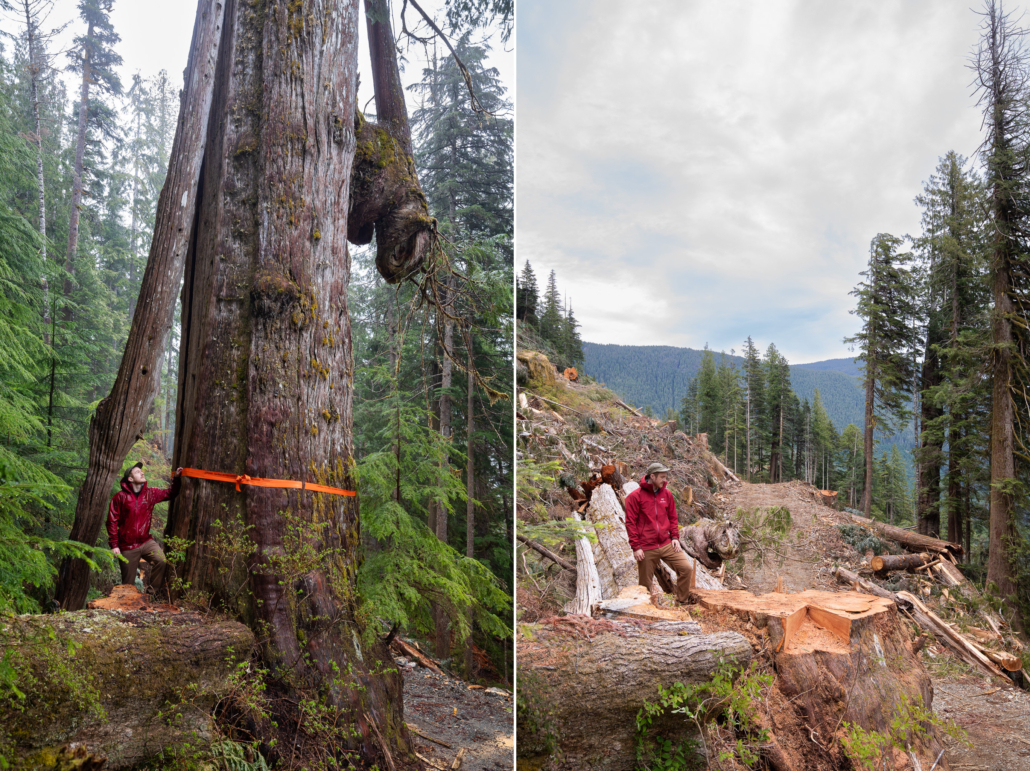
(TJ Watt/Ancient Forest Alliance)
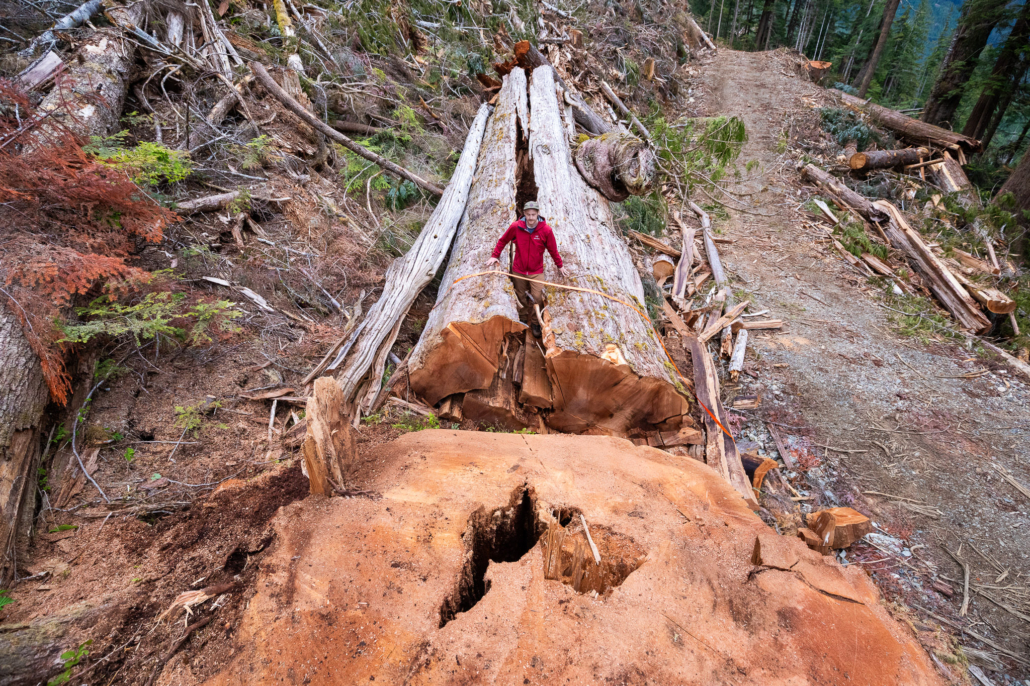
(TJ Watt/Ancient Forest Alliance)
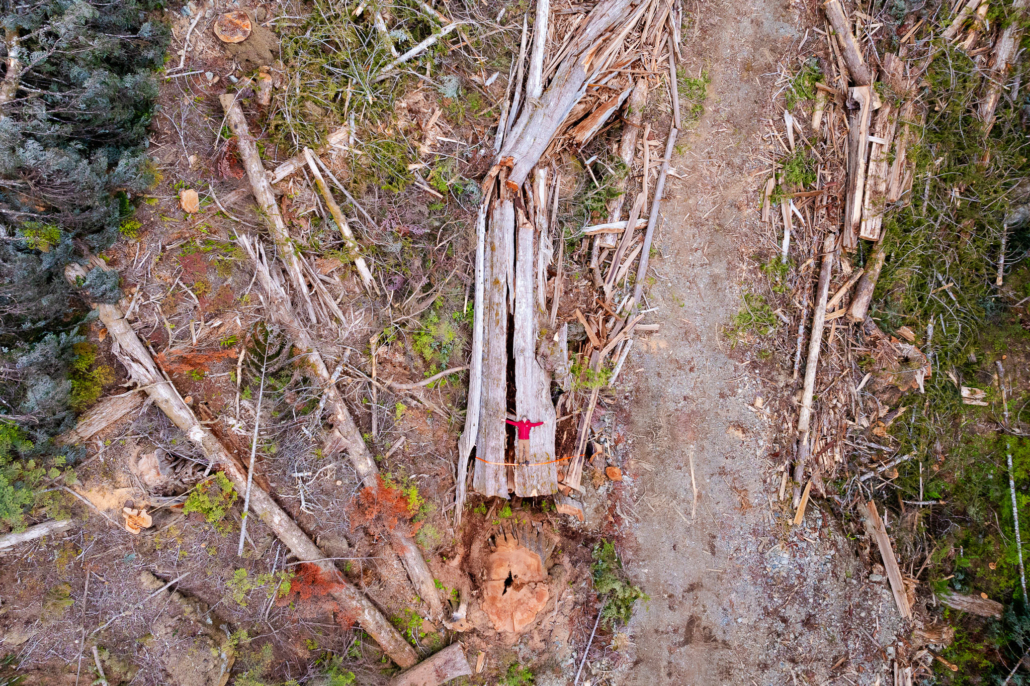
(TJ Watt/Ancient Forest Alliance)
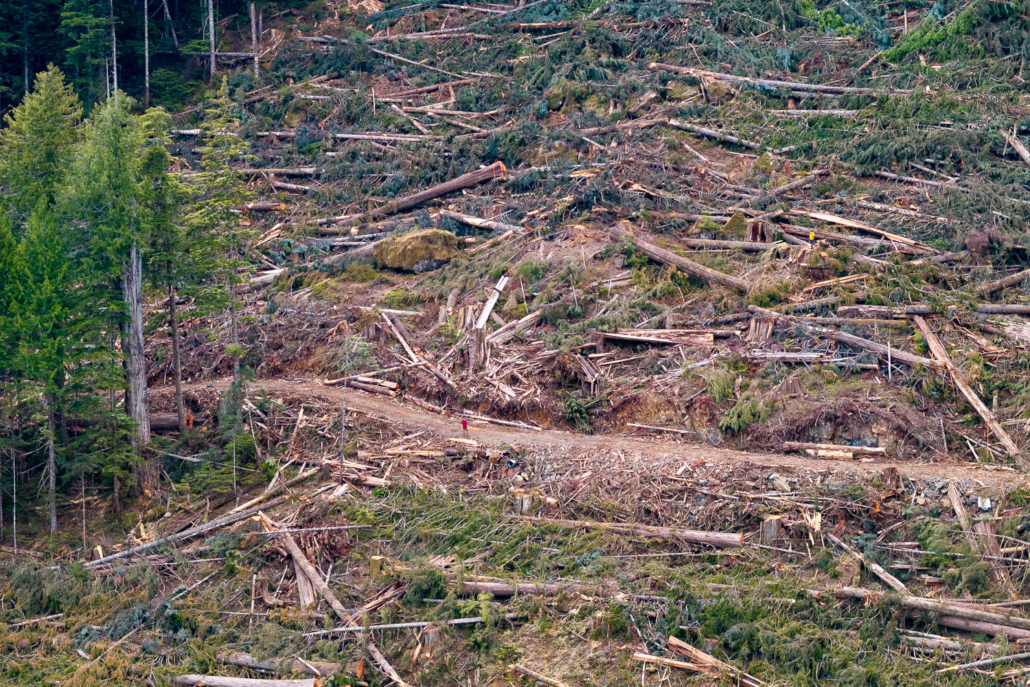
(TJ Watt/Ancient Forest Alliance)
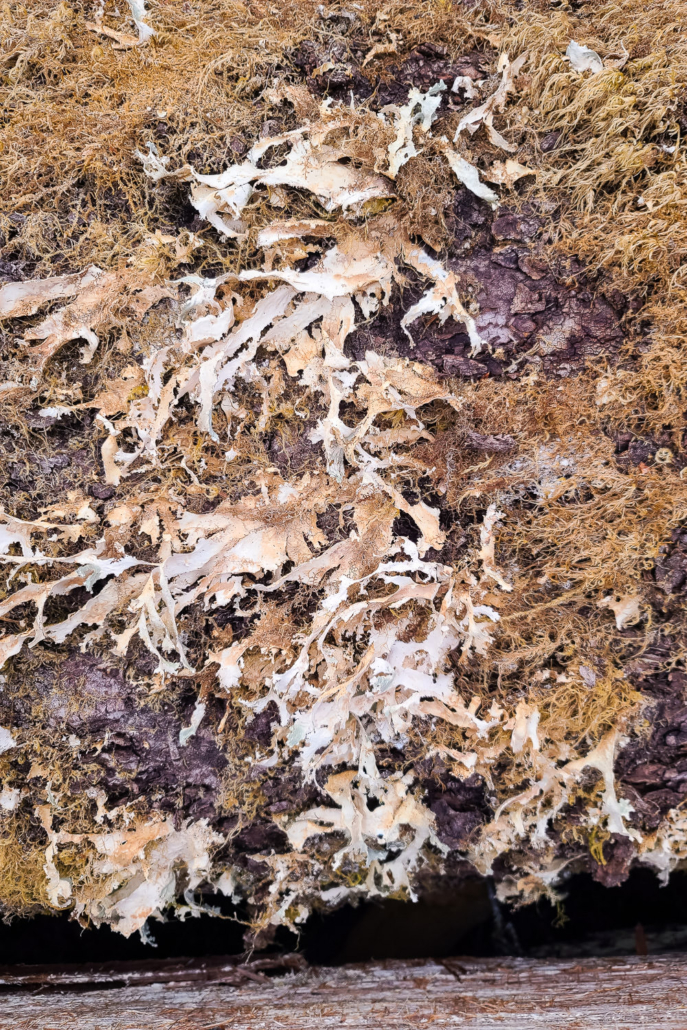
Specklebelly lichen (TJ Watt/Ancient Forest Alliance)
For Immediate Release
July 2, 2024
Shocking photos and drone footage reveal “old-growth carnage” as trees upwards of 9 feet (3 meters) wide and more than five hundred years old are logged under the management of BC Timber Sales in the famed Nahmint Valley on Vancouver Island, BC. Conservationists are urging the BC government to immediately identify substantial tracts of misidentified at-risk old-growth forests that should be eligible for logging deferrals that may have been missed due to data errors, to provide deferral funding or “solutions space” funding to First Nations to facilitate the protection of these stands, and to implement “ecosystem-based” protection targets. A species at risk, oldgrowth specklebelly lichen, was also documented in the now logged area, potentially for the first time in the Nahmint Valley.
Conservationists with the Ancient Forest Alliance (AFA) have documented the clearcutting of a superlative ancient forest in the Nahmint Valley near Port Alberni in the territory of the Hupačasath, Tseshaht, and Yuułuʔiłʔatḥ First Nations. The clearcut spans 17.4 hectares or roughly 31 football fields and contains scores of giant old-growth trees, including monumental redcedars and rare, old-growth Douglas-fir trees. The cutblock was home to oldgrowth specklebelly lichen, a species at risk found only in old-growth forests, as well as being mapped as suitable habitat for the endangered marbled murrelet. BC Timber Sales (BCTS), the BC government’s own logging agency, auctioned off the forest for logging, and trees are still being felled at the time of this release. The Nahmint is legally designated a Special Management Zone for biodiversity and is famed for its crystal blue river waters, record-sized old-growth trees, diverse wildlife, and high recreational values.
“When I first visited this endangered forest several months ago, I was amazed by its sheer beauty. It was filled with massive old-growth trees, gardens of ferns and wildflowers carpeted the forest floor, and birdsong filled the air. It was like stepping into a lost world,” recounted TJ Watt, campaigner & photographer with the Ancient Forest Alliance. “When we returned last week, it was old-growth carnage. The shattered bodies of ancient cedars lie where a vibrant and biodiverse ecosystem once stood. Premier Eby has shown a willingness to move forward on greater old-growth protection in BC but is still coming up deficient in many areas, and it’s time he directed BC Timber Sales – the BC government’s logging agency and the ones responsible for planning and approving this logging – to lead by example. What we’ve documented here is brutal and will leave many people outraged.”
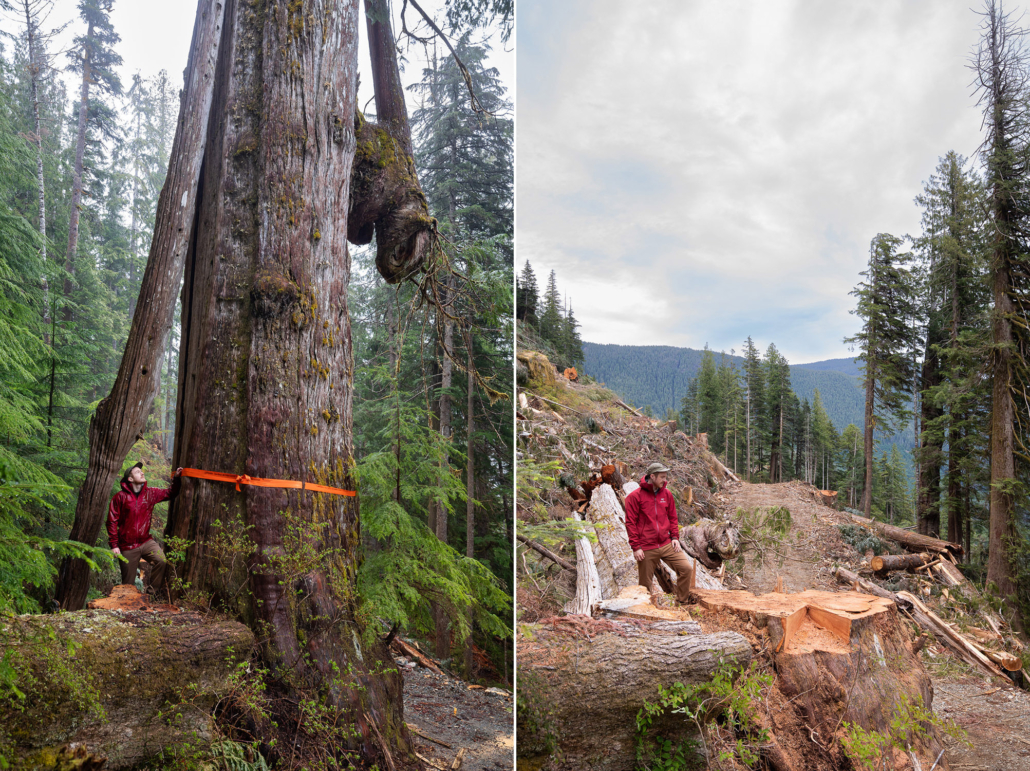
Before and after the logging of an ancient redcedar roughly 9 ft (3 m) wide in the Nahmint Valley in 2024.
Over the past year, the BC NDP government has set the stage to vastly expand the protection of old-growth forests and other ecosystems across BC by allocating and securing significant funding for conservation financing, committing to protect 30% of the province by 2030, creating a draft Biodiversity and Ecosystem Health Framework, and more (see backgrounder below). Several critical government conservation policy gaps and funding needs remain, though, namely deferral funding for First Nations and ecosystem-based protection targets, thus allowing for the continued destruction of the most at-risk old-growth ecosystems. The only path to fully protecting old-growth forests in British Columbia is via First Nations consent and shared decision-making, including on lands managed by BC Timber Sales. However, the BC government can and should facilitate that process by allowing the addition of misidentified at-risk old-growth stands into logging deferral areas, providing deferral funding, and proactively engaging First Nations about potential Indigenous Protected and Conserved Areas (IPCAs) in the high conservation value areas in their territories.
“The monumental stumps and giant fallen logs here in the Nahmint are fresh evidence that major conservation policy and funding gaps remain that the BC NDP government must address,” notes Watt. “We need legally binding ecosystem-based protection targets that would aim new protected areas at the most at-risk ecosystems, such as the big-tree old-growth forests. These could be included in the forthcoming Biodiversity and Ecosystem Health Framework. At least $120 million in dedicated deferral or “solution space” funding is also urgently needed to support logging deferrals by helping offset any lost revenues for First Nations being asked to accept them in their territories, along with proactive efforts from the BC government to identify forests that meet the criteria for deferral but were missed in the initial mapping exercise. These solutions would have presented the greatest opportunity for protecting this forest and others like it, wherever they may be found on the landscape.”
This forest was initially identified as being an at-risk, big-tree old-growth forest by the province’s independent science panel, the Technical Advisory Panel (TAP). However, it was not included in the 2.6 million hectares of priority big-tree old-growth deferrals, likely due to provincial inventory mapping errors that lumped together the areas of big trees with adjacent areas of less productive forest. The TAP specifically identified the issue of inventory errors in their report to the BC government, stipulating that any big-tree old-growth forests that were misclassified in the provincial datasets should be identified through on-the-ground assessments and immediately deferred.
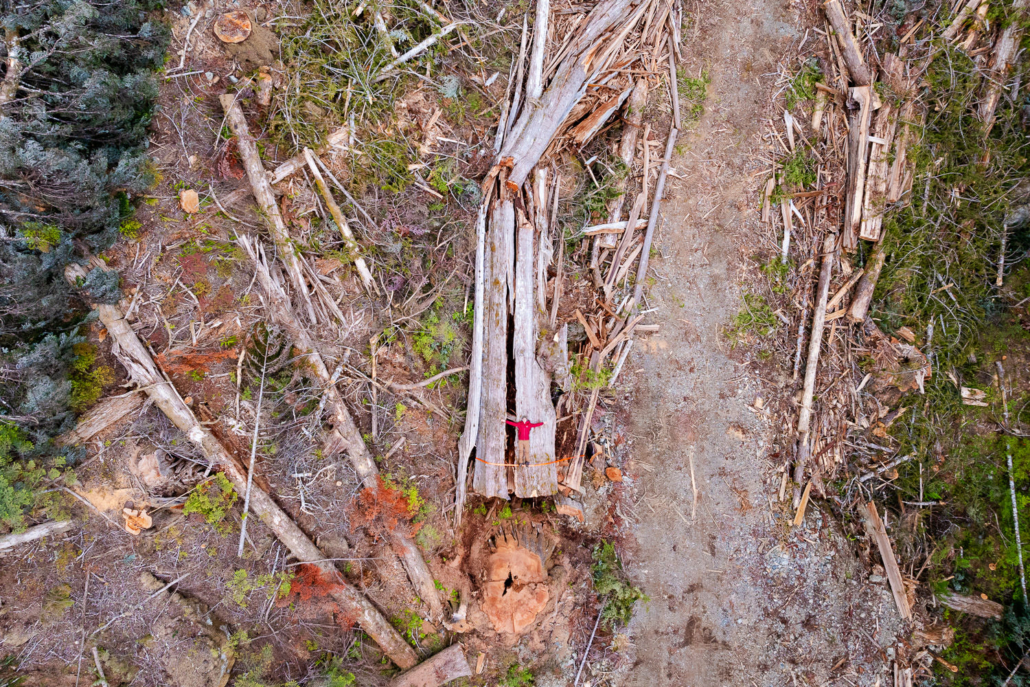
AFA photographer TJ Watt lays atop a giant fallen cedar for scale.
“When it comes to verifying forests for logging deferral, the Ministry of Forests is currently playing a game of old-growth subtraction in favour of the timber industry, facilitating more old-growth logging rather than less,” stated Watt. “As per their current policy, BC Timber Sales is actively using field verification to remove forests recommended for deferral that don’t meet the TAP criteria, but do not use the same practice to identify at-risk old-growth forests that may have been missed for deferral, such this one, so they have a chance at being added in and eventually protected. To help identify these at-risk stands, forest engineers should be legally bound to field-verify planned logging cutblocks against the TAP deferral criteria and report any discrepancies to the BC government so adjustments can be made. Citizens and scientists should also be able to submit the locations of key old-growth stands they’ve identified, which Forest Service foresters would then verify. Government data gaps and an approach that skews towards protecting the least amount of old-growth possible are leading to the loss of irreplaceable ancient forests vital to supporting endangered species, First Nations cultures, the climate, clean water, wild salmon, and tourism. Premier Eby should be instructing government staff to close this conservation loophole immediately.”
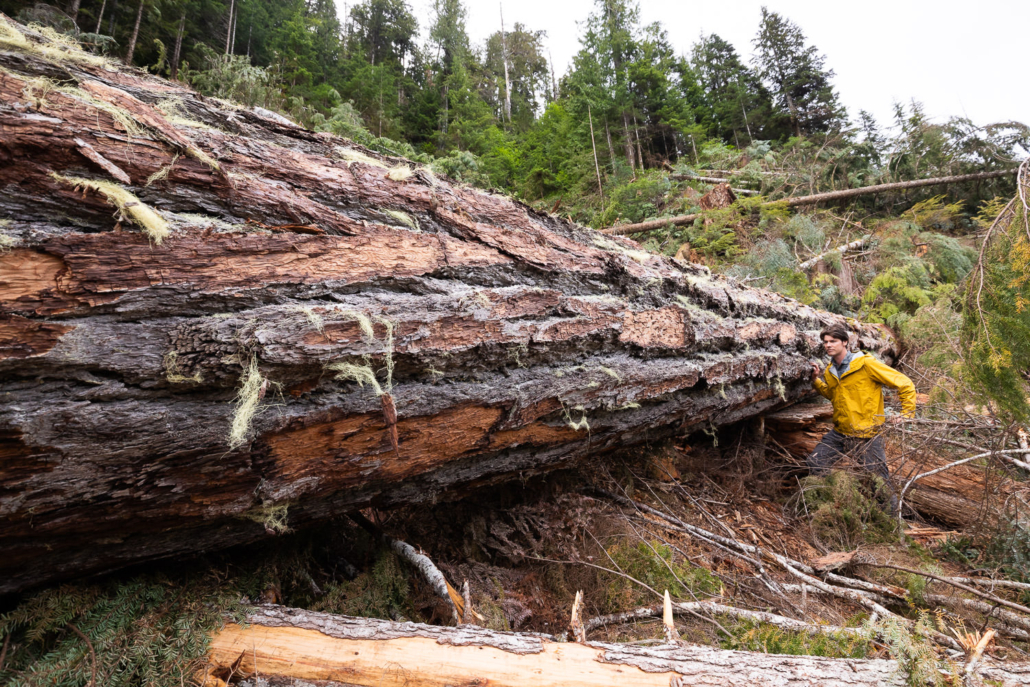
AFA researcher Ian Thomas beside the trunk of an old-growth Douglas-fir tree cut down in June 2024 in the Nahmint.
The Nahmint Valley has long been recognized as a place of exceptional ecological value. The province designated it a “high biodiversity emphasis” Special Management Zone to help protect its old-growth values and safeguard threatened ecosystems. Despite that legal requirement, successive governments have opened the Nahmint up to devastating logging practices, destroying some of the most magnificent forests on earth.
“The Nahmint is a Special Management Zone established to ensure old-growth values are maintained and biodiversity is safeguarded. And yet you see the liquidation of a threatened ecosystem home to countless species, including this rare old-growth dependent lichen species, observed possibly for the very first time in the Nahmint Valley, dying as it was discovered,” noted Ian Thomas, a researcher with the Ancient Forest Alliance. This forest was a rich, priceless ecosystem that is impossible to replace. It wasn’t a big multi-national corporation, but government staff who planned the logging of a forest that contained rare, big-tree old-growth and was home to at-risk species. All of this is in a landscape that is supposedly managed to protect biodiversity. Does the Ministry of Forests believe this is what putting ecosystem health before timber values looks like? If there were anywhere you might expect the promised ‘paradigm shift’ in forest management, it would be here in the Nahmint Valley.”
– See our information explaining the central importance of ecosystem-based targets and forest productivity distinctions.
– See our media release from May 2024 for a comprehensive list of the actions still needed from the BC government to protect old-growth forests and endangered ecosystems in BC.

AFA’s TJ Watt (red) and Ian Thomas (yellow) provide scale to the scene of destruction.
The Ancient Forest Alliance has fought for years to ensure greater protection for the old-growth forests in the Nahmint Valley. In 2018, the Ancient Forest Alliance exposed the logging of hundreds of hectares of spectacular ancient forests, including some of the largest trees in Canada. Ancient Forest Alliance filed a complaint with the independent BC Forest Practices Board, which found that the provincial government failed to adequately protect the exceptional ecological values of the Nahmint. In 2021, the resulting report from the independent Forest Practices Board found that the province was failing to adequately safeguard the ecological health of this Special Management Zone.
In 2022, the BC government released a draft landscape unit plan for the Nahmint Valley, placing some additional areas of old-growth forest into landscape reserves such as Old-Growth Management Areas. Though a welcome step, this planning was carried out under the previous paradigm where conservation could not significantly impact timber harvesting. As a result, the findings of the Technical Advisory Panel were not considered, and only about 30% of the productive forests were put into conservation reserves. Biologists agree that when ecosystems fall below 30% of their original extent, they are at high risk of irreversible biodiversity loss, and at least 70% of the original old-growth forests should be protected from logging to ensure long-term ecosystem health. In the Nahmint Valley, additional old-growth groves, including forests explicitly recommended for deferral by the Technical Advisory Panel that should have been protected in the draft landscape plan, are already planned for logging. Should BC Timber Sales’ future plans move forward, it will further fragment and destroy the old-growth forests of this remarkable valley.
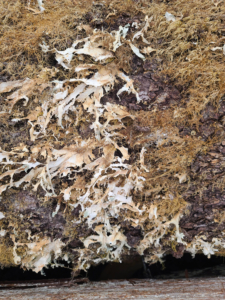
AFA has now documented what is likely the first known occurrence of old-growth specklebelly lichen in the Nahmint Valley (according to the page 21 summary list of known locations from 2015). Oldgrowth specklebelly lichen is federally and provincially listed as a species at risk, with only 52 known colonies in Canada. The highly sensitive lichen species depend on the humid microclimate of intact old-growth forests. The specimens observed were already dead or dying in the exposed clearcut. A photo of the lichen, which had lost much of its bluish colour after being in the sunlight, was sent to expert lichenologist Trevor Goward, who confirmed its presence. The provincial recovery plan for the species calls for the protection of each of these rare colonies from logging in order to “maintain all known extant populations and any future populations that may be found in British Columbia.” However, no formal legal protection exists.
Across BC, the BC NDP government has taken historic strides toward expanding the protection of old-growth forests and other endangered ecosystems across BC, such as securing over $1 billion in federal-provincial funding through the BC Nature Agreement, creating a $300 million conservation financing fund, committing to expanding protected areas in BC to 30% by 2030, drafting a Biodiversity and Ecosystem Health Framework still currently under development, and now undertaking discussions with dozens of First Nations on potential new Indigenous Protected and Conserved Areas (with several major protected areas recently announced, including ten new Conservancies in Clayoquot Sound and a 2000 square kilometer new Klinse-za/Twin Sisters Provincial Park in the far north). However, without dedicated “ecosystem-based” protection targets, in general, the most threatened and biodiverse ecosystems will continue to be largely excluded from new protected areas, which will focus on less-contested ecosystems at higher elevations and in the far North.
Old-growth forests support endangered species, First Nations cultures, the climate, clean water, wild salmon, and tourism. Under BC’s current system of forestry, second-growth tree plantations are typically re-logged every 50–60 years, never to become old-growth again.
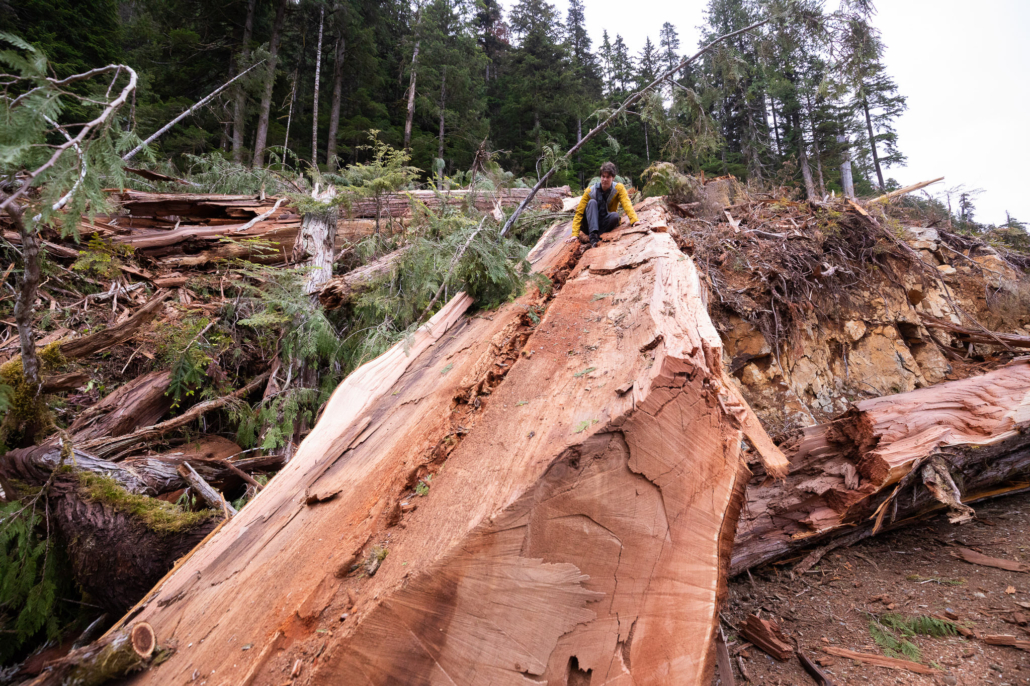
For Immediate Release
May 10, 2023
Shocking photos and drone footage reveal the destruction of rare, big-tree old-growth forests on northern Vancouver Island in Quatsino Sound, highlighting the urgent need for dedicated funding to enable both temporary logging deferrals and permanent, Indigenous-led protected areas initiatives.
Conservationists with the Ancient Forest Alliance have documented with photos and video the clearcutting of a magnificent ancient forest in Quatsino Sound and are urging the BC government to immediately commit funding for old-growth protection to help prevent further loss of the most endangered old-growth forests in BC, plus identify at-risk old-growth forests for deferral that were missed due to mapping errors in the original process.
Ancient Forest Alliance (AFA) members TJ Watt and Ian Thomas came across the fallen remains of a grove of enormous western redcedars — some measuring upwards of 10 feet (3 metres) wide, on a field expedition in 2022. The 25-hectare old-growth cutblock, an area equivalent to over 50 football fields, is located on public lands in Tree Farm Licence 6, which is held by logging company Western Forest Products in Quatsino territory.
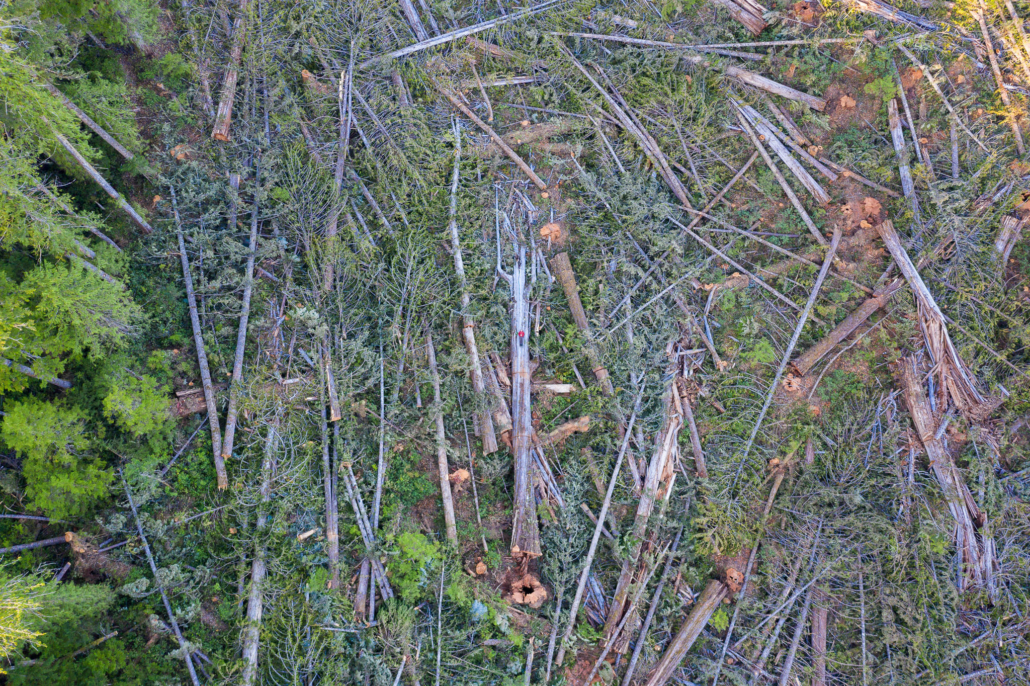
AFA’s TJ Watt provides some scale by lying down on the trunk of an old-growth western redcedar tree recently cut by Western Forest Products in Quatsino Sound.
“This was a superlative ancient forest,” stated AFA photographer and campaigner, TJ Watt. “I was floored by the sheer number of monumental redcedars that had been cut down. It was the most shocking example of industrial old-growth logging I’ve witnessed since the logging in the Caycuse and Nahmint Valleys. Dozens of centuries-old trees littered the ground, trees that were taller on their side than I was standing beside them. Some of them were alive earlier that day. After more than a century of high-grade logging in BC, groves of unprotected giants like these are extremely rare to find. To lose another one as special as this is heartbreaking.”
In November 2021, the BC government agreed to implement temporary logging deferrals in 2.6 million hectares of the most at-risk old-growth forests in BC. These priority deferrals were identified by an independent old-growth science panel, the Technical Advisory Panel (TAP), to prevent irreversible biodiversity loss while long-term land use plans are developed. To date, about 1.2 million hectares, or 46%, of priority deferral areas have been agreed upon by First Nations (whose consent and support are a necessity for any new deferrals or protected areas). More than half the areas recommended are still open to logging.
Despite being home to scores of giant trees, many of which would have been 500+ years old, this particular grove — and likely hundreds of others — was not included in the TAP’s original deferral recommendations due to the forest being incorrectly labelled as 210 years old in the province’s forest inventory database (40 years younger than the province’s 250-year-old threshold for being considered old-growth on the coast and to be included in deferral mapping).

A massive old-growth redcedar tree logged on Vancouver Island in Quatsino Sound
The TAP specifically mentioned the issue of inventory errors in their report (see pages 9, 10, 13), making clear recommendations to the BC government that on-the-ground assessments should be used to identify and defer big-tree old-growth forests that were missed in their preliminary analysis. Thus far, it appears the BC government has only used field verification to remove deferral areas that don’t meet the TAP criteria (which are to then be replaced with those that do) in order to facilitate logging, but they are not actively working to identify key old-growth stands that were missed during the TAP analysis due to mapping or inventory errors.
“Knowing that this irreplaceable ancient forest could potentially still be standing today if the BC government was using field verification to identify and defer old-growth forests missed due to mapping errors is a punch in the gut,” stated Watt. “We’ve continually raised this issue with the BC government but so far our concerns have been brushed aside. They only want to subtract old-growth from the priority most-risk category and not add any, even when it is their mistake. Citizens and scientists should be able to submit the locations of old-growth forests that meet the criteria for priority deferral but that have been missed for various reasons. Forest companies should also be obligated to field-verify cutblocks against the TAP deferral criteria before getting approval for logging. These images highlight the devastating impacts on the landscape due to provincial policy and funding gaps.”
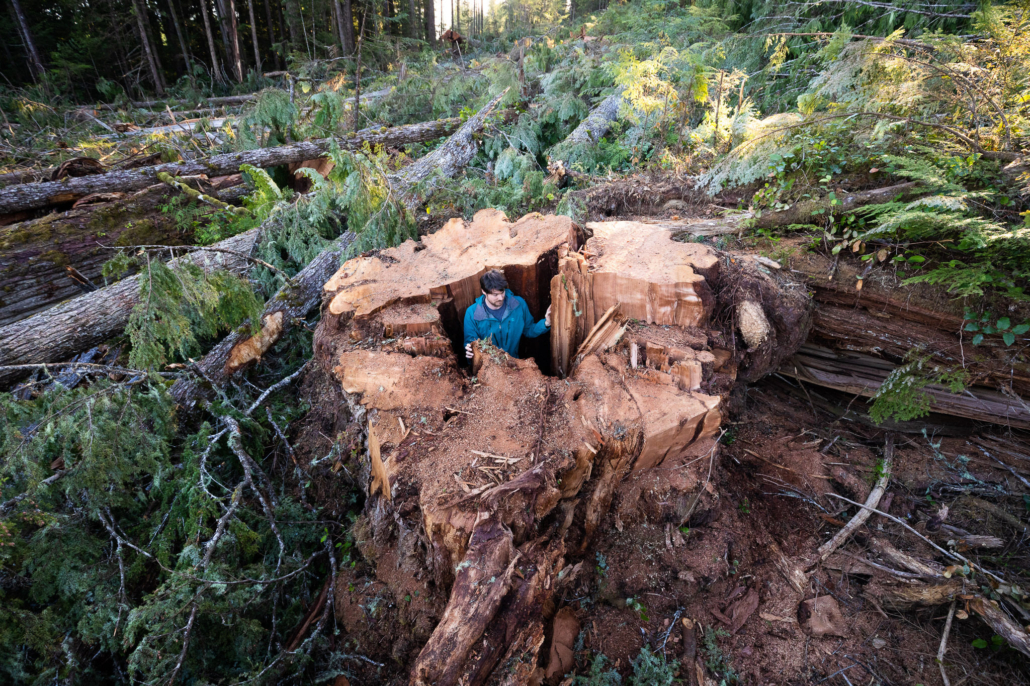
AFA’s Ian Thomas stands inside a nearly 10 ft (3 m) wide stump of a fallen western redcedar.
Conservationists argue that without significant funding, it will be nearly impossible to secure the full suite of priority old-growth logging deferrals and their eventual permanent protection, especially in the highest-value old-growth forests with the biggest trees that are most coveted by industry.
“The BC government must come to the table with immediate funding, both in the short and long term, for the deferral and protection of old-growth forests,” explained Watt. “At least $120 million in ‘solution space’ funding is needed immediately to help facilitate logging deferrals by ensuring that First Nations communities aren’t forced to choose between setting aside at-risk old growth and generating revenue for their communities. In the longer term, at least $300 million in conservation financing is needed from the province and another $300 million more from the feds, as well as hundreds of millions more from private donors, to support First Nations’ sustainable economic development, stewardship jobs, and creation of new Indigenous Protected and Conserved Areas (IPCAs) linked to protecting the most at-risk old-growth forests and ecosystems. This can include new land-use planning, Indigenous guardians programs, and the development of sustainable economic alternatives to old-growth logging such as tourism, clean energy, sustainable seafood harvesting, non-timber forest products, and value-added, second-growth forestry.
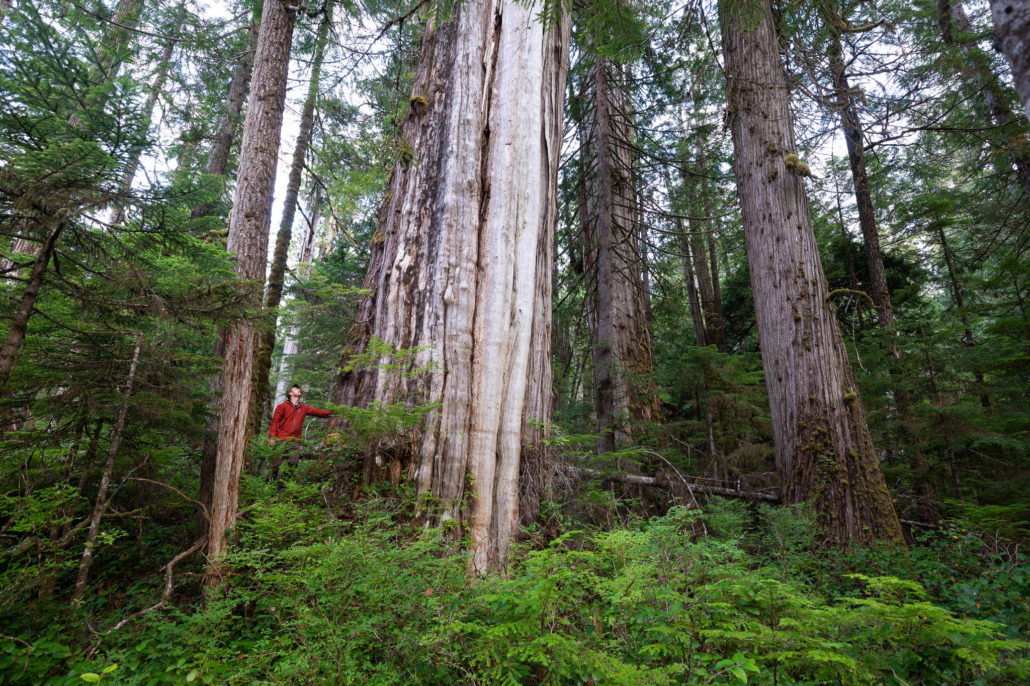
TJ stands beside a massive redcedar tree growing unprotected adjacent to the cutblock in Quatsino Sound.
Under pressure, the province recently committed to creating a new conservation financing mechanism by the end of June to be filled with philanthropic and private contributions but has yet to publicly commit any of its own funding towards the initiative. The long-awaited BC Canada Nature Agreement and the recent multi-billion dollar provincial budget surplus provide excellent avenues for securing the estimated $800-$1B+ in overall funding necessary to protect the majority of endangered old-growth ecosystems across BC
The Quatsino region on Vancouver Island has historically been hit hard by industrial logging, with less than 25% of its productive (big tree) old-growth forests remaining. Conservation biologists agree that when ecosystems fall below 30% of their original extent, they are at high risk of irreversible biodiversity loss. Despite this ecological emergency, nearby old-growth groves, including some forests specifically recommended for deferral are currently flagged for logging
“Driving to this ancient forest, one must pass through mile after mile of industrial tree farms that have replaced the once magnificent old-growth rainforests of Quatsino Sound. This grove was one of the last fragments of rich old-growth forest remaining in the area, a crucial reservoir of biodiversity and ecological resilience in a damaged landscape,” stated Watt. “Witnessing the disappearance of the last unprotected stands of old-growth forests on Vancouver Island leaves one with a profound sense of ecological grief. The BC government can and must use its vast resources to help pave the path toward the protection of what still remains.”
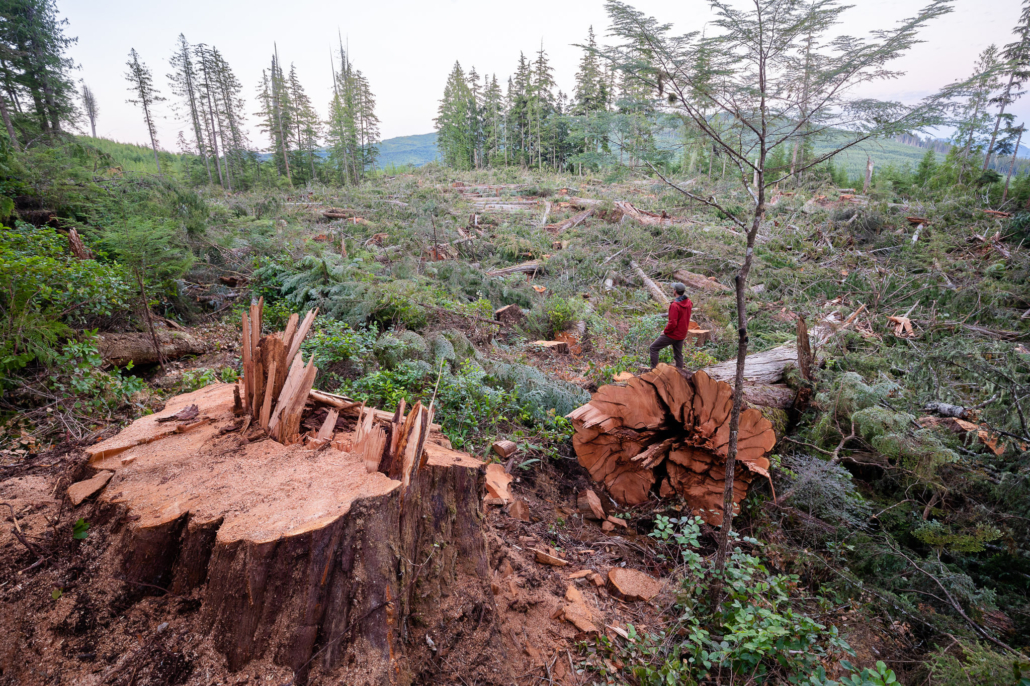
The BC government has committed to protect 30% of BC’s land area by 2030, to develop a conservation financing mechanism to support Indigenous Protected and Conserved Areas by the end of June, and to target protection for the most biodiverse areas — major commitments that the Ancient Forest Alliance commends. However, missing still is the immediate funding to facilitate deferrals among First Nations, provincial funding for conservation financing (not just a commitment to seek philanthropic funds), and ecosystem-based protected areas targets that include forest productivity distinctions.
This series of images and video is part of work Watt has created with support from the Trebek Initiative, a grantmaking partnership between the National Geographic Society and the Royal Canadian Geographical Society that supports emerging Canadian explorers, scientists, photographers, geographers, and educators with a goal of using storytelling to ignite “a passion to preserve” in all Canadians. Watt was among the first round of grant recipients in 2021 and was named a National Geographic Explorer and Royal Canadian Geographical Society Explorer.
Old-growth forests are vital to support endangered species, First Nations cultures, the climate, clean water, wild salmon, and tourism. Under BC’s current system of forestry, second-growth tree plantations are typically re-logged every 50–60 years, never to become old-growth again.
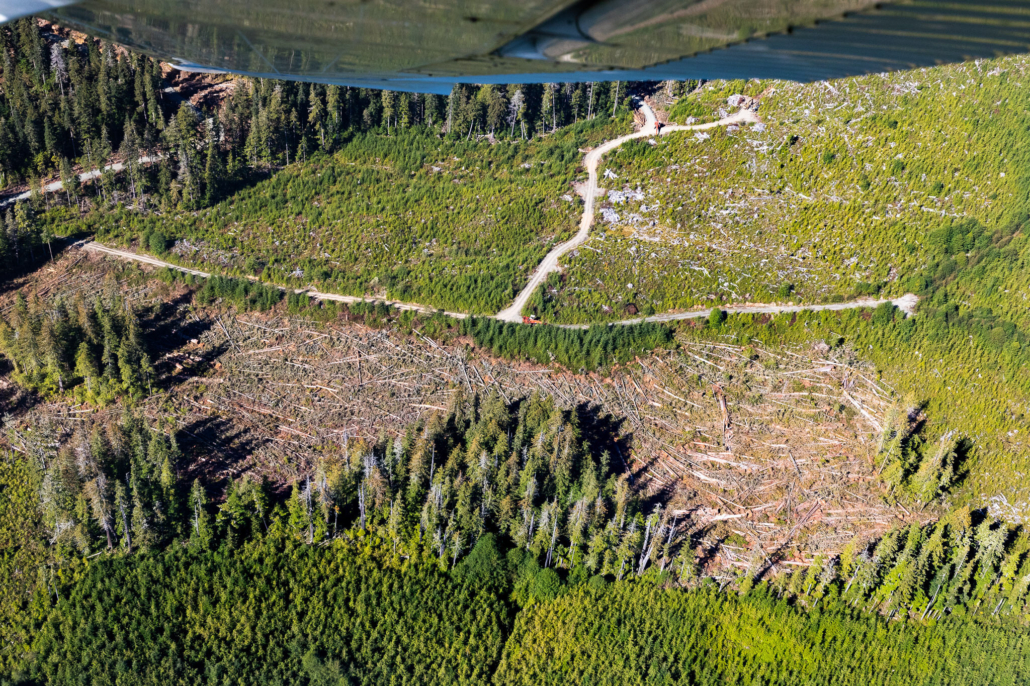
25 hectares (roughly 50 football fields) of prime old-growth forests were clearcut here in total by Western Forest Products.
For Immediate Release
November 30, 2022
In the lead-up to the UN Biodiversity Conference (COP15) in Montreal where 195 countries will meet next week to negotiate new international protected areas targets and policies, the Endangered Ecosystems Alliance (EEA) and the Ancient Forest Alliance (AFA) are calling on the BC government to commit to the federal protected areas targets to protect 25% by 2025 and 30% by 2030 its land and marine areas, at a bare minimum, and to ensure a significant federal-provincial funding package (the “Nature Agreement” that is currently being negotiated) that directs funding for the right “places, parties, and purposes” needed to ensure an effective protected areas system in BC.
The federal government has committed $3.3 billion over 5 years to expand terrestrial ($2.3 billion) and marine ($1 billion) protected areas, along with several billion dollars more for “natural climate solutions” that often overlap with nature protection initiatives.
BC’s share of those funds are between $200 to $400 million, yet the province has neither embraced the federal funds nor committed its own funds – nor even embraced the federal protected areas targets yet.
For the protection of the most at-risk old-growth stands, the federal government has also earmarked $55 million in a BC old-growth fund (a campaign for this fund was spearheaded by the Endangered Ecosystems Alliance with the Union of BC Indian Chiefs in 2020), contingent on BC providing matching funding for a total old-growth fund of $110 million – which again the BC government has not committed to.
For almost 2 years, the federal and BC governments have been in negotiations to develop a bi-lateral Nature Agreement on a funding package with protected areas targets for BC, yet still nothing has been announced just 1 week from the start of the UN Biodiversity Conference.
“Now is the time, in the lead-up to the UN Biodiversity Conference, for the BC government to commit to major federal funding and to provide its own funding on a sufficient scale. With significant funding and protected areas targets, including targets for all ecosystem types that ensures prioritization for the most underrepresented and at-risk ecosystems, such as the last of the ‘high-productivity’ old-growth stands with the biggest trees, we could see a historically unprecedented expansion of the protected areas system to safeguard the rarest and most endangered ecosystems in BC – and to end the half-century long ‘War in the Woods’. We’ve maintained for years that funding is the fundamental driver for protected areas expansion in BC, in particular to support First Nations sustainable economic development linked to new protected areas and for private land acquisition. Without this funding, major protected areas expansion in BC cannot happen at a scale and speed commensurate to the extinction and climate crises”, stated Ken Wu, Endangered Ecosystems Alliance Executive Director.
“Thousand-year-old trees with trunks as wide as living rooms and as tall as downtown skyscrapers are still being cut on a daily basis in BC. The provincial government has reaped billions from the logging of these highly endangered and irreplaceable ecosystems and now, with the planet facing a climate and biodiversity crisis that threatens the survival of even our own species, it’s time for them to give back. This means matching the federal government’s major funding commitments towards expanding protected areas in BC, adding additional funds of their own, and ensuring those funds are directed towards protecting the highest value forests that remain, not just scrub, rock, and ice. Leaving high-value old-growth forests standing needs to be made as economically viable for communities, even in the short term, as cutting them down”, stated TJ Watt, Campaigner and Photographer with the Ancient Forest Alliance.
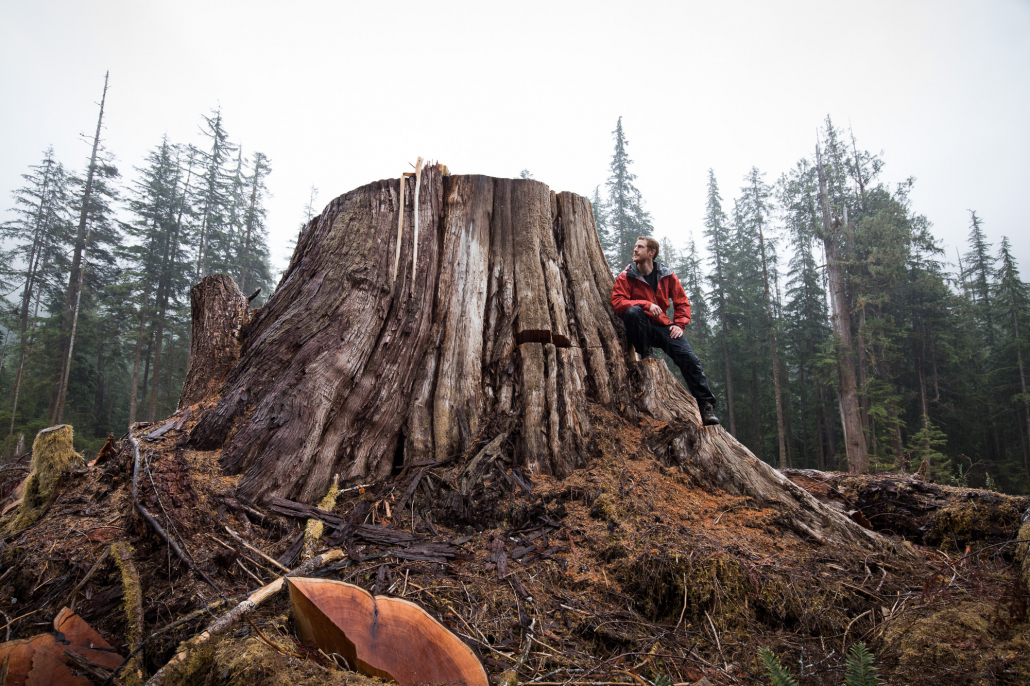
AFA’s TJ Watt beside an old-growth redcedar stump near Port Renfrew in Pacheedaht territory.
Across BC, most old-growth forests and endangered ecosystems are on the unceded territories of diverse First Nations, whose consent is a legal necessity to establish new legislated protected areas in the province. The British Columbian government is currently under pressure to help finance First Nations old-growth logging deferrals and protection, in particular to fund First Nations sustainable businesses and jobs linked to new protected areas, a process known as “conservation financing”. Across BC, numerous First Nations have an economic dependency on old-growth timber revenues that has been facilitated and fostered by successive provincial governments. Unfortunately, the provincial government has not committed the key funding to First Nations to help them develop economic alternatives to old-growth logging (in such industries as tourism, clean energy, sustainable seafood, or non-timber forest products like wild mushrooms) as was done in years past to secure the protection for large sections of BC’s Central and North Coast (ie. the Great Bear Rainforest) and Haida Gwaii, and as is currently underway to protect most of Clayoquot Sound. Without the key funding, many or most cases First Nations will have no choice but to default back to the status quo of old-growth logging on large parts of their territories.
That is, major funding worth several hundred million dollars is needed to support sustainable economic alternatives (ie. business development) for First Nations communities linked to Indigenous Protected and Conserved Areas and old-growth logging deferrals. Compensation currently exists for First Nations forestry workers (ie. the labour side) via the province’s $185 million fund to support BC forestry workers affected by old-growth logging deferrals, while the province has also provided $12 million (an insufficient amount) to help First Nations undertake land-use planning, including assessing old-growth logging deferrals and the impacts to their communities. However, it is the “business side” of the equation – the largest part of funding needs, estimated to cost about $600 to $800 million for First Nations in order to supplant their old-growth logging interests (for example, to protect much of the Great Bear Rainforest, which is 6% of the land area in BC, $120 million in conservation financing was brought in from environmental groups and the provincial and federal governments, and tens of millions more in carbon offset funding) that will enable them to protect the most at-risk old-growth forests in BC – that is lacking from government at this time. Additional funds are also needed by First Nations to protect non-old-growth forest ecosystems as well – second-growth forests, grasslands, wetlands, etc.
At its core, to actually protect the most contested and endangered high-productivity old-growth forests sought after by the timber industry with the biggest trees and greatest biological richness, the conservation financing for First Nations businesses must be tied to supplanting old-growth logging interests specifically in the stands most coveted for logging. Simply providing capacity funding or labour support, or even economic development funding not linked to protecting the most valuable old-growth timber, is a recipe for the biggest and best old-growth stands to still fall, while new protected areas skirt around these monumental stands and instead protect smaller trees in the lower-productivity old-growth stands typically at higher elevations, in poor soils or in boggy landscapes, and that have fewer species at risk and which are far more represented in the existing protected areas system.
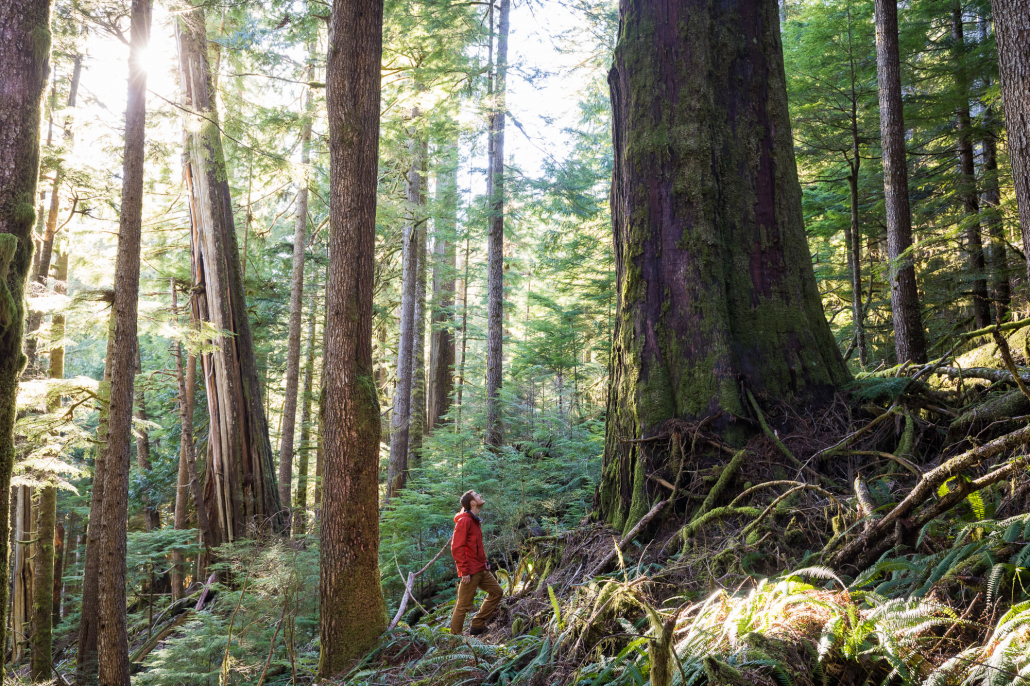
Unprotected old-growth forest at risk of future logging on Edinburgh Mountain near Port Renfrew in Pacheedaht territory.
In addition, to protect endangered ecosystems and old-growth forests on private lands, provincial and federal government funding is needed to purchase these lands. In BC, only about 5% of the lands are privately owned, concentrated on southeastern Vancouver Island, in the Lower Mainland, and in major river valleys in BC.
If the BC government ends up providing major funding and adopting the federal protected areas targets with a new Nature Agreement deal, there are still ways the agreement can come up short. For such a deal to be most effective, the funding must be directed to the key “places, parties, and purposes”:
Places: Priority must be given to the most endangered ecosystems that are most at risk from industry – in particular logging, agricultural conversion and suburban sprawl – in the major valley bottoms and lower elevations in southern BC where most of the people and industry are, and by no coincidence where most species and ecosystem at risk are. The government will tend to protect vast areas of lower productivity “rock and ice” – alpine areas at high elevations and far northern forests with minimal timber value in order to maximize the hectares protected for PR purposes and that minimize the impacts to most industries, which also minimizes protection for the vast majority of species and ecosystems at risk. These alpine, subalpine, far northern, and bog ecosystems are native ecosystems that deserve protection, but a far greater emphasis must be on saving the most contested, endangered ecosystems right now given the current ecological crisis.
The government also has to stop its “creative accounting” on how much they claim is protected in BC. About 15% of BC is in legislated protected areas – however, in some of its PR claims, the province has sometimes been adding an extra 4%, largely in tenuous conservation regulations, known as Old-Growth Management Areas and Wildlife Habitat Areas, that lack the permanency (OGMA’s can be moved around in chunks and logged, for example) and/or the standards (oil and gas and some logging is allowed in some types of WHA’s) of real protected areas.
Parties: Priority should be given to First Nations sustainable economic development linked to new protected areas and conservation reserves. Legally mandated corporate compensation for logging, mining and oil and gas companies should be years down the road – First Nations must come first, being Nations, as they decide the fate of their unceded territories. Land acquisition funding for private lands is also important.
In addition, as most First Nations have not initiated new land use planning processes where protected areas are decided, it is vital that much of the funding be “open” and uncommitted at this time to help drive protection options during the land use planning processes over the next couple years.
Purposes: Funding for the development of sustainable businesses for interested First Nations that is linked to new protected areas is by far the largest amount of funding needed – smaller funds are needed for First Nations capacity around land-use planning and deferral assessments and for interim jobs and labour needs. Without this core business development funding, protected areas will be add-ons that will largely skirt around the status quo of old-growth logging in the core areas with the biggest trees. The excuse of government saying that “First Nations haven’t been telling us they want conservation financing” is both incorrect in many cases, and often disingenuous when they haven’t even raised the possibility of any major conservation financing to First Nations.
Increasing the economic dependency of communities on old-growth logging, whether First Nations or non-First Nations, is the wrong approach for these conservation funds, including tenure buy-backs if they lack legal conservation measures to protect the remaining old-growth and endangered ecosystems.
Provincial funds are also needed from other sources – but not from the conservation funds of a Nature Agreement – to support incentives for a value-added, second-growth forest industry and the expansion of a smart, second-growth engineered wood products industry in general across BC.
It should also be noted that forestry revenue-sharing agreements do not constitute “conservation financing” for First Nations, contrary to the recent PR-spin of the BC government – quite the oppositive, it entrenches the economic dependency of the communities on old-growth logging (which would be akin to sharing oil and gas revenues, and then expecting the communities to then stop oil and gas activities).
“We hope the new Premier David Eby takes this chance for a major protected areas funding agreement of a sufficient size and with ambitious targets, aimed at the most endangered ecosystems and that prioritizes support for First Nations. He can end the War in the Woods and ensure the protection of the amazing diversity of endangered ecosystems across BC – what a great start to his first 100 days that would be and a historic leap forward for the planet!” stated Ken Wu, Endangered Ecosystems Alliance Executive Director.

EEA Excutive Director, Ken Wu, beside an incredible unproteted old-growth redcedar at Jurassic Grove near Port Renfrew in Pacheedaht territory.
More background info:
Old-growth forests are vital to support endangered species, First Nations cultures, the climate, clean water, wild salmon, and tourism.
Protecting nature is not only vital to avert the extinction crisis and the climate crisis (by drawing down vast amounts of atmospheric carbon into protected forests, grasslands, and wetlands) but research shows that nature and protected areas are vital for our health and for the economy.
Increasing studies show that being in forests and nature supports our mental and physical health, reducing all sorts of ailments and boosting our immune systems. Recent research has even shown that many trees and plants emit a defensive compound called “phytoncides” which boost our immune systems when we breathe them in.
Studies also show that protected areas, including protecting old-growth forests, attract and foster more diverse, resilient, and prosperous economies, including supporting businesses and jobs in the tourism and recreation sectors; commercial and recreational fishing industry by sustaining clean water and fish habitat; real estate industry by enhancing property values in communities near protected green spaces; non-timber forest products industries like wild mushroom harvesting; high tech sector by attracting skilled labour that locates to areas with a greater environmental quality of life; and by providing numerous ecosystem services that benefit businesses.
The province appointed an independent science team, the Technical Advisory Panel, in 2021 who recommended that logging be deferred on 2.6 million hectares of land with the grandest (biggest trees), oldest and, rarest old-growth stands while First Nations land use plans are developed over a couple years to decide which areas are permanently protected in legislation. These recommended deferral areas have been put forward by the BC government for the consent of local First Nations to decide which areas get deferred. Currently about 1 million of the recommended 2.6 million hectares (ie. 40%) are under deferral, while some areas have been logged. Unfortunately, the provincial government has not committed any concrete funding to First Nations to offset their lost revenues should they accept old-growth logging deferrals in areas where they have logging interests, nor to help them develop economic alternatives to old-growth logging.
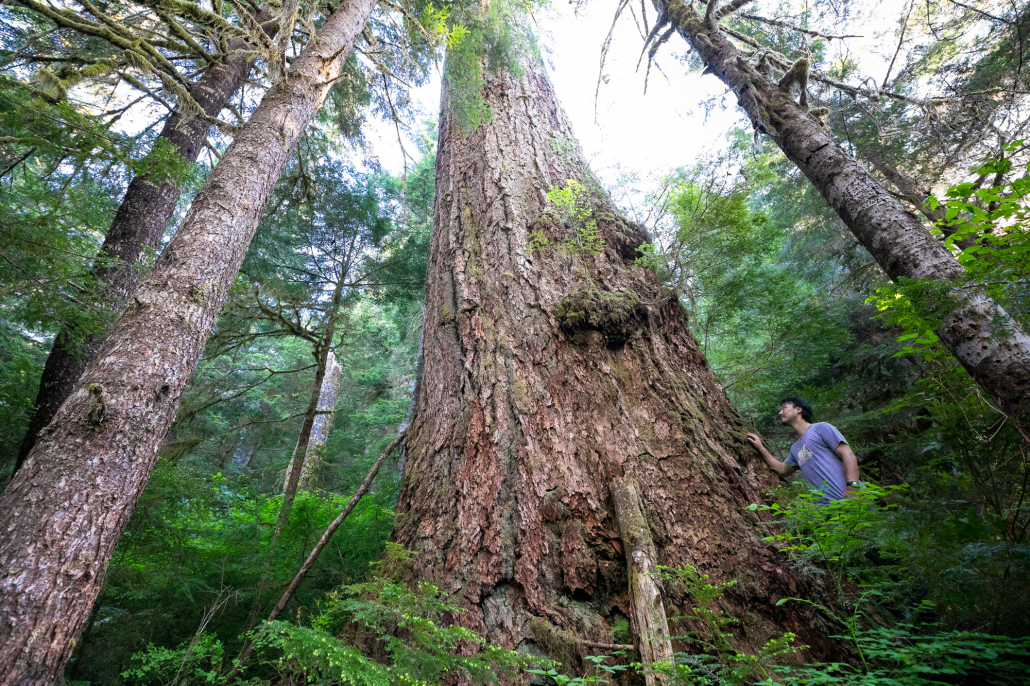
EEA Executive Director, Ken Wu, by an old-growth Douglas-fir in the Nahmint Valley near Port Alberni on Vancouver Island in Hupacasath, Tseshaht, & Uclulet territory.
Looking for a sustainable gift idea this Valentine’s Day? Why not show your love for ancient forests AND those close to you by dedicating a donation to the AFA in honour of a loved one. Click here to visit our donation page, select ‘yes’ under Dedicate, write your personalized message, and voila! your Valentine’s Day gift will go towards protecting ancient forests. Please note: If you wish for your message to be received by Valentine’s Day, choose the email option. Thank you for your generous support!
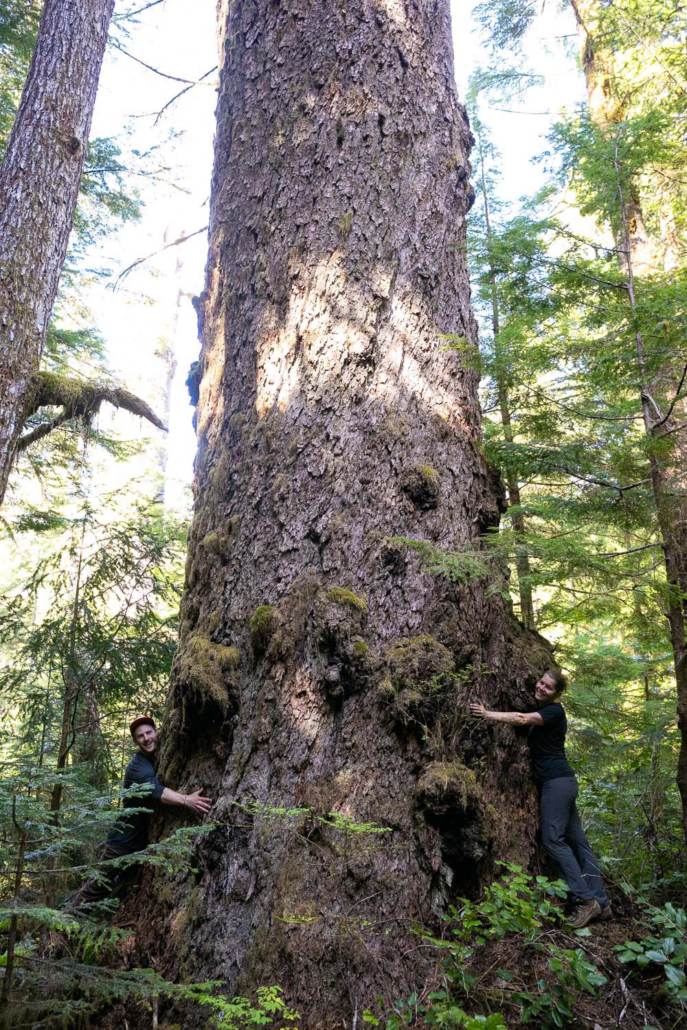
The Ancient Forest Alliance team wishes to thank Andrea Inness, who will be departing in early February after devoting five years as a Forest Campaigner with the AFA, including three and a half years on the Executive Team. With her strong work ethic, intelligence, advanced logistical skills, and sense of responsibility, Andrea helped lead the Ancient Forest Alliance to numerous campaign and organizational successes over these years.

Andrea was prolific in her work liaising with organizations, stakeholders, allies, and government, writing, speaking, researching, exploring old-growth forests, and working behind the scenes with internal organization management. Her professional skills, experience, and dedication helped pressure the provincial government to start moving towards comprehensive, meaningful protection for ancient forests in BC.
“I’m very proud of the work AFA has accomplished with the help of our many caring, passionate supporters. There is hope for the future of old-growth forests because we have refused to give up and have continued to expand and strengthen the ancient forest movement,” stated Andrea. “I’m grateful for my time at the AFA, for the opportunity to help protect the magnificent old-growth forests in BC, and for the people I’ve had the privilege of working with along the way.”

“I feel confident leaving AFA at this point in time. The campaign has entered a new chapter, with the province now listening to the best available science and committing to major policy changes. The organization is in good hands with both new staff who have a wealth of knowledge and experience to bring to the table, and long-term and dedicated staff,” she concluded.
We are grateful to Andrea for all she has done for the AFA and the campaign to protect old-growth forests. We wish her every success in her next exciting chapter.

The Globe and Mail
November 6, 2021
In British Columbia’s Nahmint Valley, an 11th-hour reprieve was issued this week for ancient forests that were slated for logging.
The valley, in central Vancouver Island, features massive old western redcedars and some of the province’s largest Douglas fir trees, and is home to Roosevelt elk, black-tailed deer, cougars, wolves, black bears and threatened species such as the marbled murrelet and northern goshawk. It has been at the centre of a long-running battle between environmental values and economic ones, as the provincial government’s own logging agency, BC Timber Sales (BCTS), oversees the falling of large chunks of the forest.
Across BC, a total of 2.6 million hectares of rare, old-growth forests may be spared further logging under the provincial government’s new approach to forestry, which recognizes that these ecosystems are irreplaceable. On Nov. 2, Forests Minister Katrine Conroy announced the province’s largest-ever commitment to preservation. The first step isto suspend logging in one-third of the rare, old-growth forests, which are considered at a very high risk of irreversible biodiversity loss. The measures are temporary, but intended to allow time for the government to fully develop its plan, which will make the health of British Columbia’s forests an overarching priority.
There is a catch: Most of the proposed logging moratoriums are subject to what may be lengthy consultations with Indigenous communities. But the province has immediately put the brakes on new logging through BCTS, which accounts for one-fifth of all of BC’s annual forestry harvest. For the bulk of the proposed deferrals, the province will make no changes until it conducts individual consultations with 204 First Nations, a process that, optimistically, the province hopes to complete in 30 days.
Meanwhile, BC will continue to harvest trees in old-growth forests, some essentially undisturbed since the last ice age, as part of an industry that still contributes mightily to the provincial coffers.
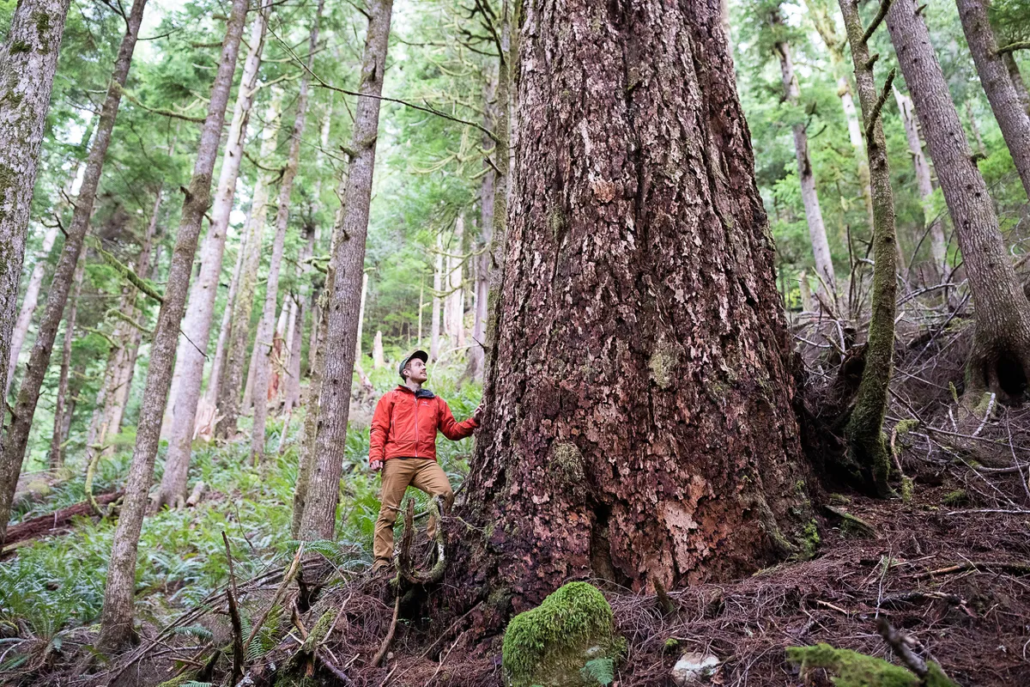
Ancient Forest Alliance campaigner and photographer TJ Watt beside an old-growth Douglas-fir tree in a planned BC Timber Sales cutblock that is now deferred from logging in the Nahmint Valley near Port Alberni.
TJ Watt has spent years bushwhacking through the Nahmint Valley for the non-profit Ancient Forest Alliance, documenting both the old-growth giants and the logging that targets the biggest and most valuable stands of trees. Since the announcement on Tuesday, he has been studying the deferral maps to see what the changes mean.
“We’ve documented some of the earth’s largest trees being cut down there by BC Timber Sales, and we’ve continued to highlight the forest that remains at risk in that valley. And today, I’m excited to look at these maps and see that there is a real change coming,” he said.
The valley has been heavily logged, same as the surrounding region. The nearest town is Port Alberni, a forestry-dependent community where the first commercial sawmill opened in 1860.
The San Group opened a $70-million sawmill in Port Alberni in 2020, the first major investment in coastal sawmilling in 15 years. Kamal Sanghera, the chief executive officer, said his company’s five mills are already struggling to obtain raw materials to process, but if halting BCTS operations in places such as the Nahmint Valley leads to reforms of the system, he can support the changes.
“We need to cut less and create more value,” Mr. Sanghera said in an interview Friday. “The system now is wrong. We are shipping raw logs overseas, while guys like us can’t get supply.”
Conflict over old-growth forestry is a familiar story in BC, which was described internationally as the “Brazil of the North” 30 years ago. In 1992, the provincial government appointed an independent Commissioner of Resources and Environment in a bid to resolve these conflicts with a consensus-based land use strategy. Consensus remains elusive, and while the industry has changed, timber harvesting remains entrenched as a priority over values such as biodiversity.
One factor has changed significantly. In 1992, Indigenous communities struggled to influence land-use decisions in their traditional territories. Today, the BC government is bound by legislation to seek consent before making new decisions about resource development.
The First Nations Leadership Council, in a statement Thursday, welcomed the deferrals but criticized the delivery, noting that some old growth remains unprotected while the consultations are carried out. As well, the council is unhappy that the province has passed responsibility to First Nations without providing financial support to replace any revenues that might be lost if they choose to defer logging old growth in their territory.
Ms. Conroy would not say whether her government is ready to offer compensation to First Nations that wish to approve deferrals. “We will work with the communities,” she said in an interview.
The government is also under fire from the forest industry, which predicts devastating consequences for jobs and communities if the deferrals are approved.
Susan Yurkovich, president and chief executive officer of the Council of Forest Industries, is shocked by the scale of the deferrals. To freeze 2.6 million hectares of old-growth forests equals an annual loss of 10 million cubic metres of timber, she said. Based on the average requirement to feed a sawmill, that would shut down up to 20 mills, and cost 18,000 jobs, she added.
The provincial government insists that the toll will be smaller: If all of the proposed deferrals go ahead, 4,500 forestry workers would be out of a job. The transition that the BC government envisions would see the forest industry extract more product, more value and more jobs out of every tree cut. But that, Ms. Yurkovich said, would require significant investments.
“To retool a mill takes millions and millions of dollars,” she said, “What is going to get people to invest is predictable access to fibre at a reasonable cost. And this announcement has created significant additional uncertainty. It is going to have a chilling effect not only for industry, but for workers.”
The bulk of the trees that are cut in BC are on Crown land, meaning that forestry companies depend on the province for their fibre supply. That is the provincial government’s bargaining chip.
“This is a new vision for how we’re going to do forestry in this province. We have to look at the whole picture, the whole ecosystem. It’s not just about looking at that tree and saying, ‘Okay, how much do I get for that when we harvest it?’” Ms. Conroy said. “Some companies have adjusted and some haven’t. If you’re going to harvest our timber in BC and reap the benefits of that, then we hope you will invest in BC They are the peoples’ forests.”
Although many communities around the province still depend on forestry, the industry’s clout has waned. In 1992, the industry provided more than 90,000 jobs; today there are about 50,000. Mills have closed around the province even as the trees continue to fall. In the past year, BC has shipped $500 million worth of raw logs overseas to be processed in other countries. Nation-wide, only Alberta gets fewer jobs out of every tree cut.
As the most valuable, old-growth forests disappear, experts warn that job losses, with or without this action, are looming.
Ecologist Rachel Holt is one of the experts the province retained to produce its 2.6-million-hectare deferral plan. “We know that the old growth is running out. In some places, it’s already gone, like the dry coastal Douglas fir forests on the east side of Vancouver Island. We couldn’t set deferrals, because there is no old growth left. And what has industry done to prepare for this? Where was the forward planning to make sure there wasn’t community disaster?”
Environmentalists have accused the BC NDP government of dragging its heels on action, but there is a sense of urgency now on display. That is partly due to domestic pressure: The mass civil disobedience that continues in Fairy Creek has put a spotlight on old-growth logging. It’s also international, as Canada makes bigger and broader commitments to conservation and climate change.
But most of the promises made this week depend on the work ahead, as the province seeks to execute what it has billed as unprecedented conservation.
First Nations, industry leaders and environmentalists all agree on one thing: This transition cannot be achieved without a significant amount of money.
“If the government wants to set themselves up for success here, they absolutely need to come to the table with hundreds of millions of dollars in conservation funding,” Mr. Watts said. “Primarily for the economic relief of First Nations communities, if they choose to defer and ultimately move to permanent protection, so that it’s not a choice between logging and making money, and protecting forests and losing money. It needs to be a fair and equitable choice.”
Read the original article
VICTORIA (Unceded Lekwungen Territories) – Conservationists with the Ancient Forest Alliance (AFA) commend a BC government announcement made today releasing independent scientific mapping of BC’s endangered old-growth forests, and in principle accepting recommendations to defer logging in 2.6 million hectares of at-risk old-growth forests. The province has also immediately deferred all future BC Timber Sales (BCTS) cutblocks that overlap with identified at-risk forests. However, critical conservation funding to enable the full scale of deferral recommendations is still missing.
A summary report and new scientific mapping produced by an independent Old Growth Technical Advisory Panel have revealed there are 5 million hectares of unprotected, at-risk old-growth forest across BC. These forests are categorized into ancient, rare, and big tree forests. The panel recommended the province immediately defer logging in 2.6 million hectares of these forests, focusing on the most critically endangered stands.

“The independent mapping is a major step forward,” stated Ancient Forest Alliance campaigner TJ Watt. “For the first time in history, the province has used the best available science to accurately identify old-growth forests at risk. This mapping confirms what conservation organizations have been saying for years: that much of BC’s forests are at risk of irreversible biodiversity loss and must be protected.”
“The province’s acceptance of the recommendation to defer logging in 2.6 million hectares of the best and most at-risk old-growth forests is also unprecedented,” stated Watt “However, these are not immediate and without a matching provincial commitment of several hundred million dollars in conservation financing, with a primary focus on First Nations economic relief linked to deferrals, the full scale of the deferrals, and eventual permanent protection, will be impossible to achieve. We have the road map in hand, but we’re missing the gas in the tank.”
A highlight of the announcement is that BCTS, which has stood at the centre of considerable controversy for the logging of some of BC’s finest remaining old-growth stands, will see immediate logging deferrals. Covering about 20% of the province’s annual allowable cut, this could represent an area of about 500,000 hectares being placed under temporary deferral. This area is larger than all protected parkland on Vancouver Island put together, vastly exceeding all deferrals in place thus far. Included in this area are some of the most critical old-growth hotspots remaining in BC, such as the Artlish, Tsitika, and Nahmint watersheds, areas that conservationists have struggled to protect for decades.
The province also announced its plan to launch a suite of programs to support workers that will be impacted by the deferrals, including connecting workers with short-term employment opportunities, education and skills training, or funds to bridge to retirement. However, the province did not announce economic relief for lost forestry revenues in First Nations communities due to proposed deferrals. $12.69 million over three years was committed to providing capacity funding for First Nations to participate in planning and negotiation, but no money has yet been committed to providing further conservation financing.

“Today’s announcement is a historic step in the right direction, but there are some critical pieces still missing,” said AFA campaigner Andrea Inness. “Besides a lack of funding, the province has failed to provide timeframes or deadlines for the implementation of deferrals or any of the OGSR recommendations. Meanwhile, at-risk old-growth forests are being left on the chopping block while negotiations take place.”
“The province needs to show leadership in supporting First Nations-led old-growth conservation. The $12 million committed today to support capacity building for First Nations to participate in government-to-government negotiations doesn’t go nearly far enough.”
“It’s about ensuring First Nations in BC have funding made available to support logging deferrals, First Nations-led land-use planning, Indigenous protected areas that conserve old-growth, and economic diversification of First Nations’ communities,” said Inness. “There must also be support for joint decision-making and Indigenous self-determination. Currently, the province doesn’t have the political will to deliver on these pieces. That needs to change.”
The federal government recently committed $2.3 billion to expand protected areas across Canada. Of this, several hundred million dollars are available for the expansion of protected areas in BC, with $50 million specifically allocated to protect old-growth forests in BC.
The Ancient Forest Alliance is urging the BC government to commit several hundred million dollars in conservation financing to match this federal funding in the upcoming spring budget.
Patagonia
July 23, 2021
As the old-growth logging crisis heats up in Canada, a photographer goes searching for trees to save them.
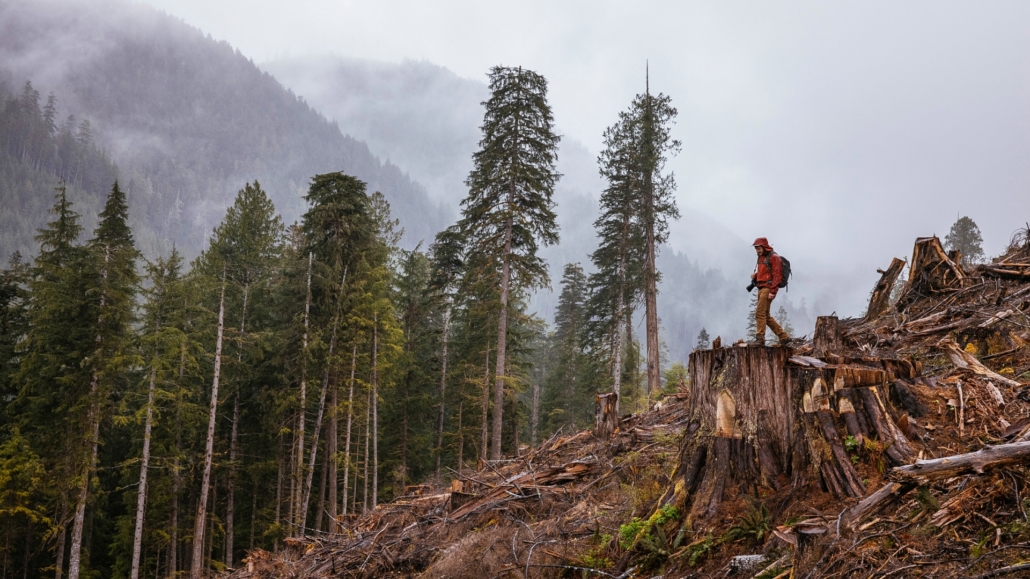
TJ Watt stands on a 12-foot-wide stump, a former old-growth Western red cedar, overlooking a recent clear cut in the Caycuse watershed on southern Vancouver Island. Photo: Jeremy Koreski
There are no trails in the old-growth coastal temperate rainforests of Canada’s southern Vancouver Island. As I follow TJ Watt through another grabby thicket of stink currant, I offer silent thanks that I’m not the one lugging the camera equipment. We plough through underbrush, wade across streams, climb over moss-covered boulders and fallen logs, and circumvent the trunks of massive trees. It takes us an hour to gain a single kilometer.
Watt moves with the dogged determination of a hunter. He doesn’t seem to tire. His purpose is to locate groves of old-growth trees—giants the size of grain silos that are hundreds or even thousands of years old—and photograph them in order to rally people to their defense through his nonprofit, Ancient Forest Alliance (AFA). He’s been building conservation campaigns this way for over a decade, nearly one-third of his life, but the stakes have suddenly gone up.
The latest science shows that old-growth coastal temperate rainforests are among the world’s best natural defenses against global warming, absorbing and storing even more carbon from the atmosphere than the Amazon tropical rainforest in South America. Yet logging companies in British Columbia continue to harvest old-growth trees, with no signs of stopping. Depending on the species, trees from this region will be turned into a variety of building materials ranging from airplane-frame components to roof shingles. Others will be made into furniture, cabinets and interior woodwork. Some will be sent to specialty mills to create components for musical instruments, like guitar soundboards. On southern Vancouver Island where Watt lives and works, 96 percent of the productive old-growth forests along the valley bottoms—where the largest trees grow—have already been logged. “Big trees are big money for the logging industry, but at a high cost to the environment,” Watt says.

In some ways, Watt is a relative newcomer to old-growth conservation efforts in British Columbia. In the ’90s, Vancouver Island was famously the epicenter of the “War in the Woods,” where mass civil disobedience arrests eventually led to the protection of Clayoquot Sound on the island’s west coast. In the last few months, hundreds of protestors have amassed at Fairy Creek in what is quickly becoming the biggest act of civil disobedience over logging in decades. Watt is taking a different approach to save these last groves: building support among diverse demographics and creating a clear, photogenic message that can ripple through the media. His vision is for the British Columbia government to implement science-based legislation that protects endangered old-growth forests across the province.
“You can’t win this one grove at a time” he says. “It has to be bigger.”
Watt didn’t know what an old-growth forest was until the age of 20. His father was among the first cold-water surfers on southern Vancouver Island, and Watt spent his youth watching waves and entering local skateboarding competitions. “I’m sure I’d seen old growth by that point in my life but just didn’t understand what I was looking at,” Watt says.
In 2005, he signed up for a public outing to the Walbran Valley, home to Canada’s most majestic red cedar forests, that was organized by the Wilderness Committee’s Victoria office. The trip opened his eyes to the grandeur of trees and their plight. “There were all these rivers and beautiful waterfalls and trees probably 16 feet in diameter, 4 or 5 meters wide,” Watt recalls, switching between metric and Imperial measurements in typical Canadian fashion. “To learn that they were at risk of being cut down just totally shocked me.”
Watt’s interest in photography started in high school when he began borrowing his mom’s camera. After graduation, he spent three months backpacking and photographing his way through Southeast Asia but wasn’t sure how to make a career out of it. He ended up back in his hometown working for his dad building houses. Once Watt started taking photos for the Wilderness Committee, he was inspired to enroll at the Western Academy of Photography. He completed the program in 2007.
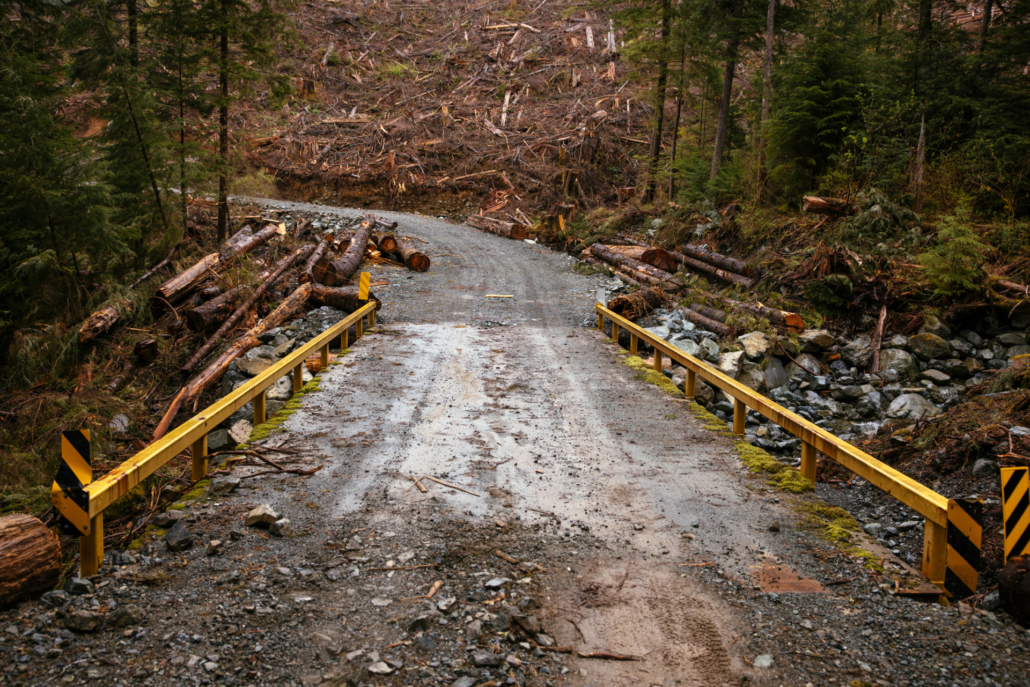
Ken Wu, then the executive director of the Wilderness Committee’s Victoria office, remembers the day Watt walked into his office and volunteered to take photos. “He was this skateboarding hippie with dreadlocks down to his waist,” Wu recalls. “I looked through his photos and thought, yeah these are pretty good.” Wu initially sent Watt to photograph environmental demonstrations in the city, but it was soon clear that Watt’s skills and interests were stronger in the wild. “He has a tremendous sense of balance, which is really important out there—old-growth forests are among the most rugged landscapes in the world,” Wu says. Wu hired Watt on contract to explore old-growth groves and take photos for marketing materials and press releases. The two men would go on, in 2010, to cofound a new environmental nonprofit, Ancient Forest Alliance, devoted to protecting Vancouver Island’s old-growth forests.
“It just was a perfect fit,” says Watt. “I loved adventure, and I loved the outdoors. And maybe because I came from a skateboarding background the jumping around through the forest part felt like a fun game.”
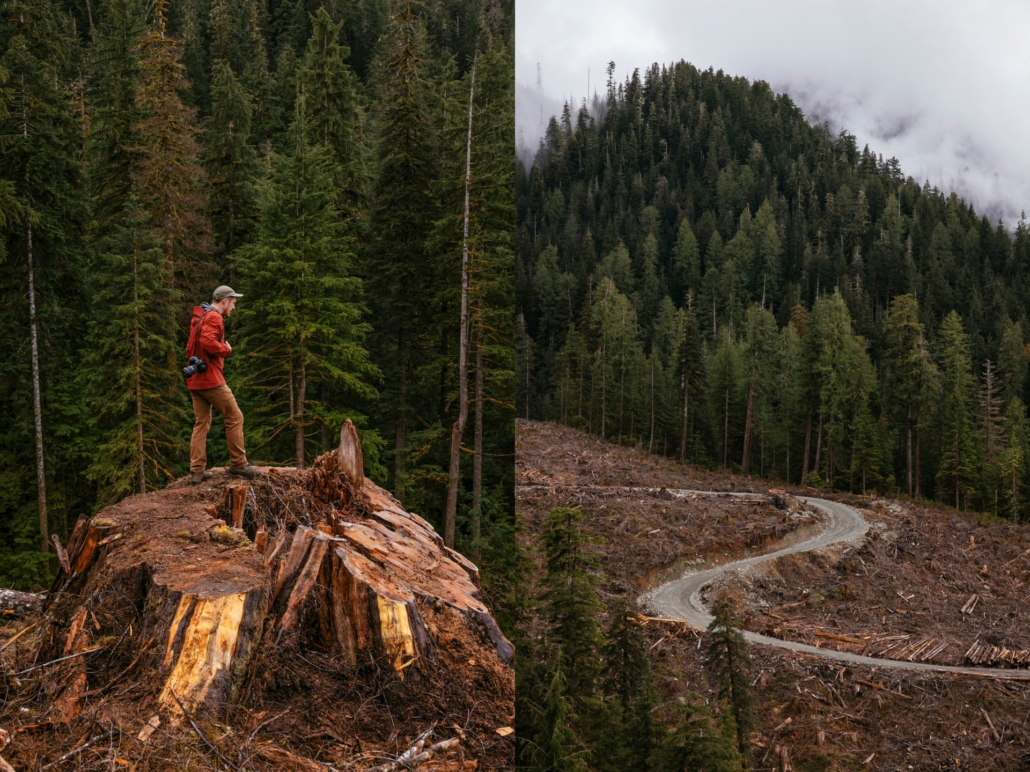
“That’s a nurse log,” Watt says, pointing out a fallen tree with new saplings starting to grow out of it. I stop, marveling at how much old-growth trees give back to the ecosystem even in death. We’re traipsing through Avatar Grove, a stand of highly photogenic red cedar and Douglas fir that Watt first came across while tree hunting in Pacheedaht territory, in the Gordon River Valley not far from the hamlet of Port Renfrew. In 2012, he worked with the Port Renfrew Chamber of Commerce to save these 50 hectares (about 124 acres) from being logged. AFA rallied volunteers to build boardwalks and viewing platforms for the trees, and in a stroke of marketing genius, they nicknamed the site Avatar Grove after the blockbuster film. Soon after, in the same region, Watt encountered a 230-foot-tall Douglas fir with a 39-foot circumference—the second-largest Douglas fir tree in Canada—standing alone in a recent clear-cut. Watt’s photos of “Big Lonely Doug” were heartbreaking and effective. Following countless news stories, Canadian journalist Harley Rustad wrote a book, Big Lonely Doug: The Story of One of Canada’s Last Great Trees, in 2018. The BC Ministry of Forests, Lands, Natural Resource Operations and Rural Development enacted permanent protection for the tree and 53 others identified by the University of British Columbia’s BC Big Tree Registry.
Port Renfrew, a former logging town, rebranded itself as Canada’s Tall Tree Capital. The results are encouraging. In non-pandemic years, local hotels and B and Bs reported a surge in demand between 75 and 100 percent each year since 2012. New businesses are opening and thriving, like Wild Renfrew, an ecotourism resort and outfitter, and Pacheedaht Pit Stop, the town’s first gas station in two decades. In a place where clear-cutting was once the only means of economic growth, residents now recognize that old-growth trees can provide just as much, if not more, value as part of a tourism-based economy. “When you cut down an old-growth tree, it’s a one-time payout,” Watt says as we climb stairs built into a fern-covered slope to reach the viewing platform for what’s called Canada’s gnarliest tree. “But this,” he says, gesturing toward the whimsical tree, a nearly 200-foot-tall cedar with big knotty burls covering its trunk, “this can provide a sustainable economy for the town indefinitely.”
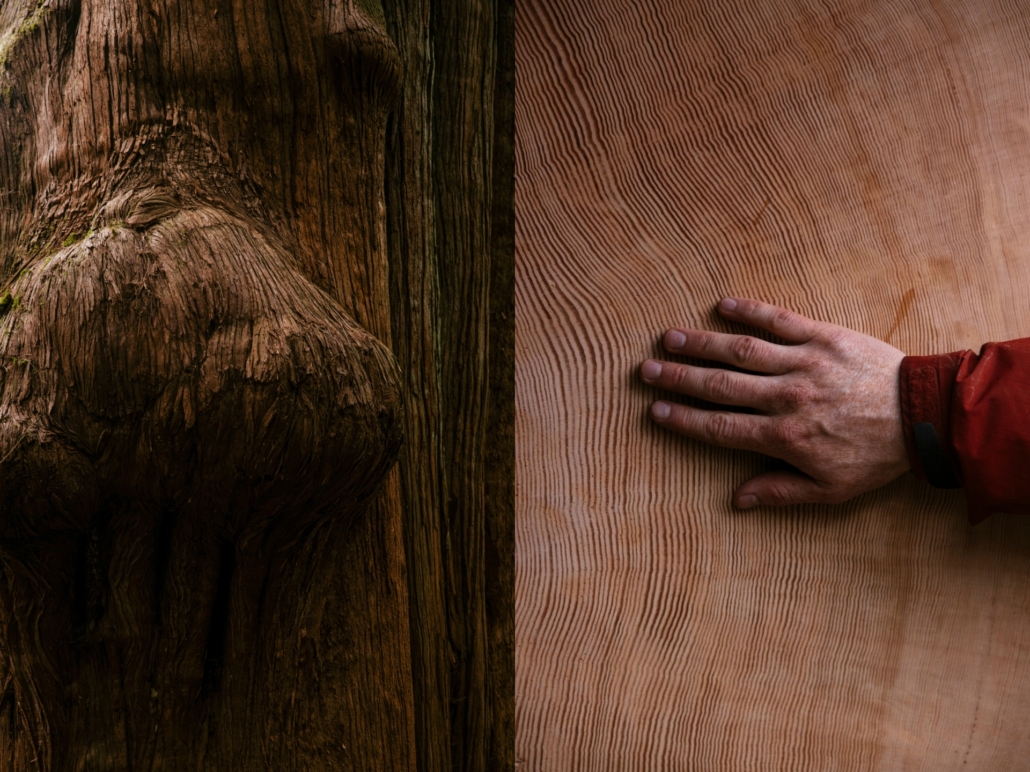
As affirming as AFA’s early success with Avatar Grove was for Watt, it was also sobering. The feat took two years of nonstop effort for Watt and Wu, who led dozens of hikes to the site and generated hundereds of news articles calling for its protection—plus what Watt calls “a heroic effort” by the Port Renfrew Chamber of Commerce and local business leaders. “It would be impossible to replicate this for every place,” Watt says as we walk back to his van. “This is one grove out of thousands that are being cut across the province at any given time. It just happened to be one we were able to showcase.”
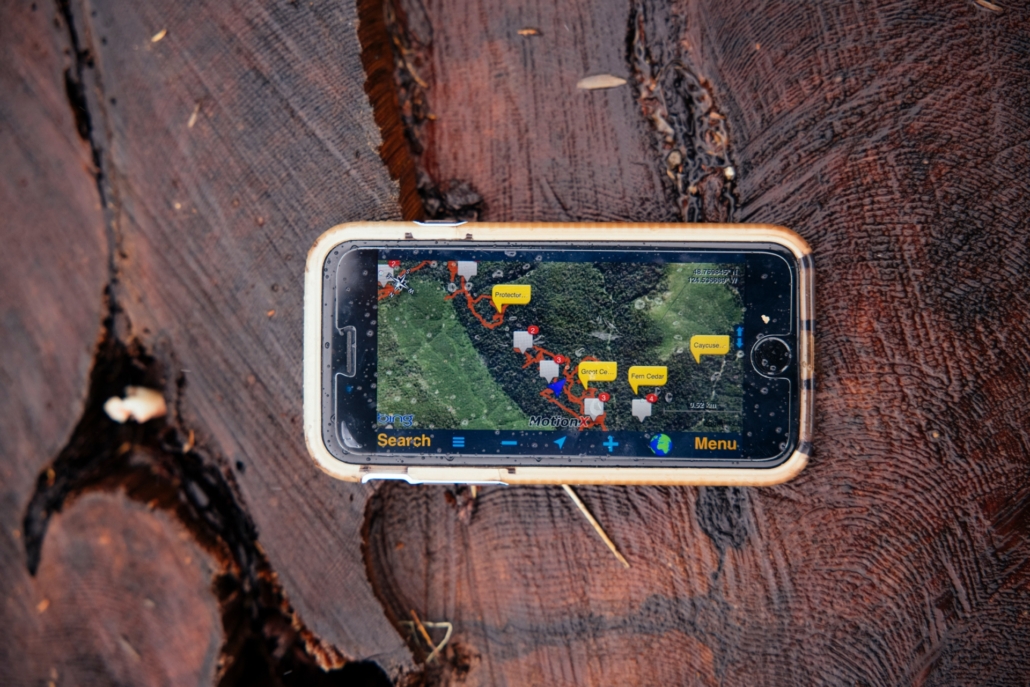
On a sunny summer day in 2020, Watt sits at his computer at the AFA office, a modest window-lined room in the Central Building in downtown Victoria. Through iMapBC, the government’s free web-mapping application, Watt can access publicly available geographic data like pending cut blocks, active cut blocks and protected Old Growth Management Areas (places such as Avatar Grove). The application enables him to overlay the data onto satellite images, providing Watt the same bird’s-eye view as the logging industry.
We’re looking at a zoomed-in section of southern Vancouver Island’s Nahmint Valley, near the small town of Port Alberni. Watt’s been analyzing satellite images for so long that he can tell the type of forest by the shape and contour of the treetops. Second growth has a lighter green coloring and appears uniform, almost like a lawn. Old growth is darker green, scruffy and rough, with conical shapes and dark shadows that Watt says indicate the tops of very tall, very old trees. “Anything outlined in green is a planned BC Timber Sales cut block,” he says as he scrolls around on the map so I can see the two dozen or so planned cut blocks marring the valley. “If you put them all together, we’re talking more than 600 football fields of old-growth trees that are intended to be logged.”
Watt first visited the cut blocks of Nahmint Valley in 2018, to photograph the old-growth logging in progress. His photos went viral. One of them, of his colleague Andrea standing on a patio-sized cedar stump with its massive trunk lying on the ground behind her, appeared in Reddit’s World News section. The photo, with the headline, “Canada’s Largest Trees Cut Down in Nahmint Valley,” ran alongside stories on Brexit and President Trump.
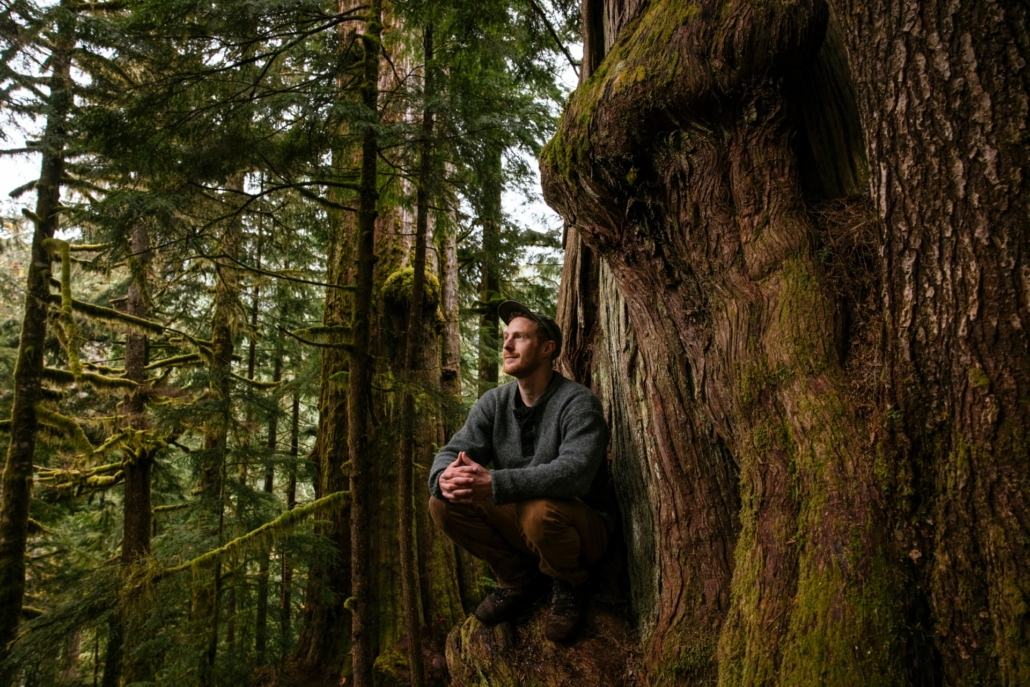
The public outcry was fierce, a crescendo to the momentum the AFA had been building for years. Around the same time, the BC Chamber of Commerce (representing 36,000 businesses) called on the provincial government to improve old-growth protection for the purpose of tourism, using Port Renfrew as an example. In response, the government of British Columbia appointed an independent panel to undertake public engagement on old growth and provide a report to the Minister of Forests, Lands, Natural Resource Operations and Rural Development. The report was expected to drastically alter the way British Columbia manages old-growth trees.
Watt pulls up a link to the 72-page report, “A New Future for Old Forests,” published on April 30, 2020. One of the panel’s 14 recommendations is to immediately defer development (translation: logging) in old-growth forests until the province can improve the way it manages them. Watt hopes the report will end the logging of endangered old growth in British Columbia once and for all—the top-down protection he’s been fighting for. “It’s no longer just environmentalists calling for this change,” he says. “It includes all kinds of non-traditional allies. It’s businesses and unions and scientists and faith groups and outdoor recreationalists.”
But a year later, Watt, Wu and all those who’d hoped for positive change are still waiting. The BC government, despite claiming full commitment to implementing all 14 of the report’s recommendations, is moving at what Watt calls “a snail’s pace.” Meanwhile, industrial logging continues to clear-cut old growth on Vancouver Island and beyond. Which means Watt is still out there with his camera.
Watt knows that Canada will lose many of the groves he photographed—no matter how ancient or charismatic the trees. Logging is just too profitable for the forestry industry, and without a new business model or government support, there’s little incentive for them to change. Ten years in, Watt says it doesn’t get any easier. He recently returned to a favorite find in the Caycuse River watershed—a monumental stand of red cedars likely 1,000-years-old—to find the entire forest clear-cut. The experience was devastating. “Once they’re gone, they’re gone,” Watt says. “Second-growth forests are logged every 50 to 80 years, never to become old growth again.” Intellectually, he knows his role isn’t to save every tree—it’s to give voice to the trees and use his photography to motivate people to get and pressure elected officials to enact greater protection for old-growth forests. That’s ultimately Watt’s (and AFA’s) goal: science-based legislation that protects old growth from the top down and a shift to a sustainable, value added second-growth forest industry instead. But emotionally, it’s tough. “I think for somebody whose greatest love is old-growth trees and forests, I have the best job in the world and the worst job in the world,” Watt says.
When we last spoke, on June 2, 2021, he was fresh off an ancient tree hunt in Fairy Creek Valley, which is adjacent to Avatar Grove near Port Renfrew. Fairy Creek is the last unprotected old-growth valley in southern Vancouver Island that’s still intact. But it’s hanging by a string. At this very minute, logging giant Teal-Jones is bulldozing the roads to access the 12.8 hectares (almost 32 acres) of mostly old growth that it plans to harvest within the Fairy Creek watershed. Environmental activists are on-site, chaining themselves to anything they can, occupying trees and staging road blockades. As of early June 2021, the RCMP (Royal Canadian Mounted Police) has arrested 185 activists. Watt is trying a new technique—aerial photography. He took his photos of Fairy Creek by helicopter. He hopes to convey the grandeur of this singular river valley by showing it in its entirety, much the way a bald eagle sees it.

Watt’s dreadlocks may be gone, and his heart has been broken by this fight too many times, but he still jumps at the chance to document the lives of the world’s most awe-inspiring trees.
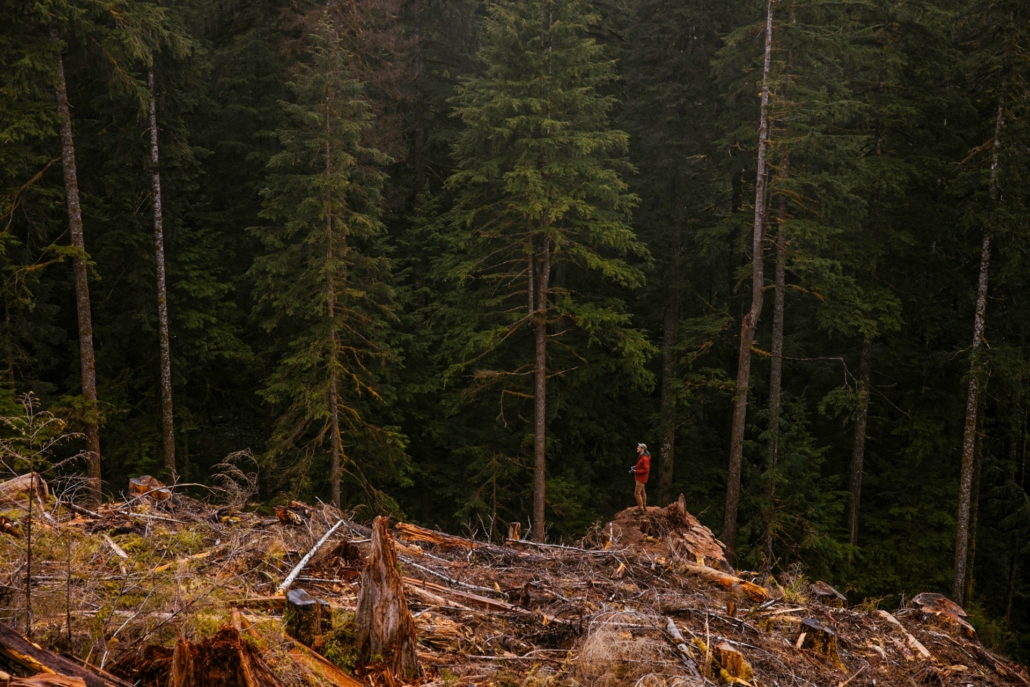
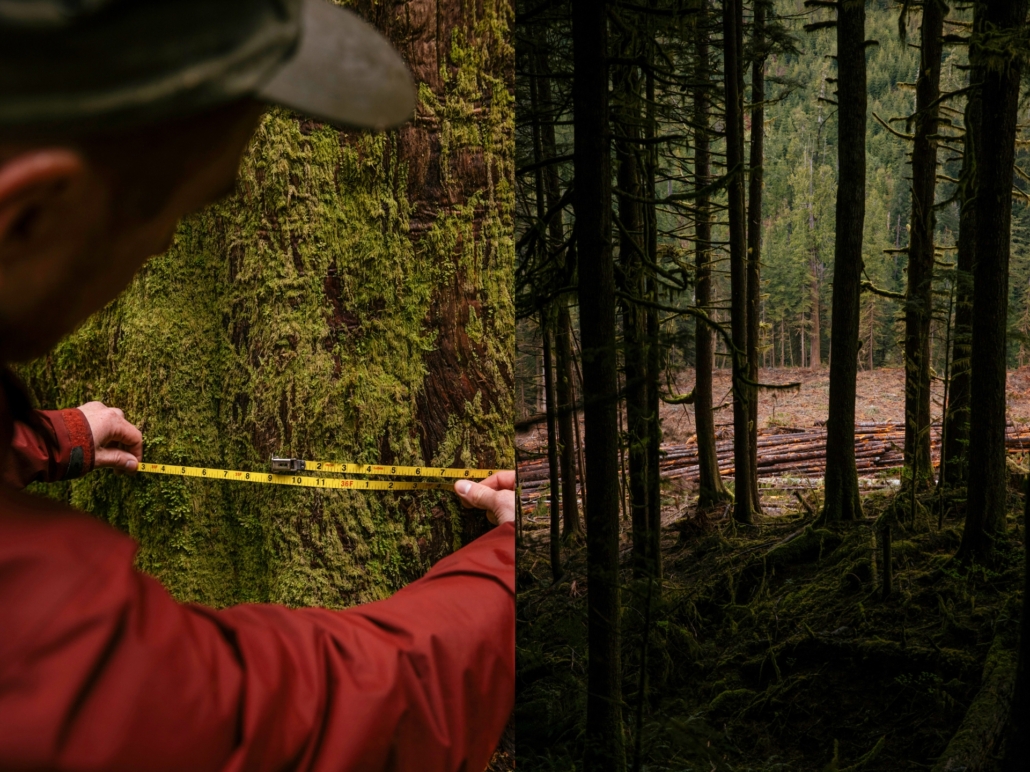

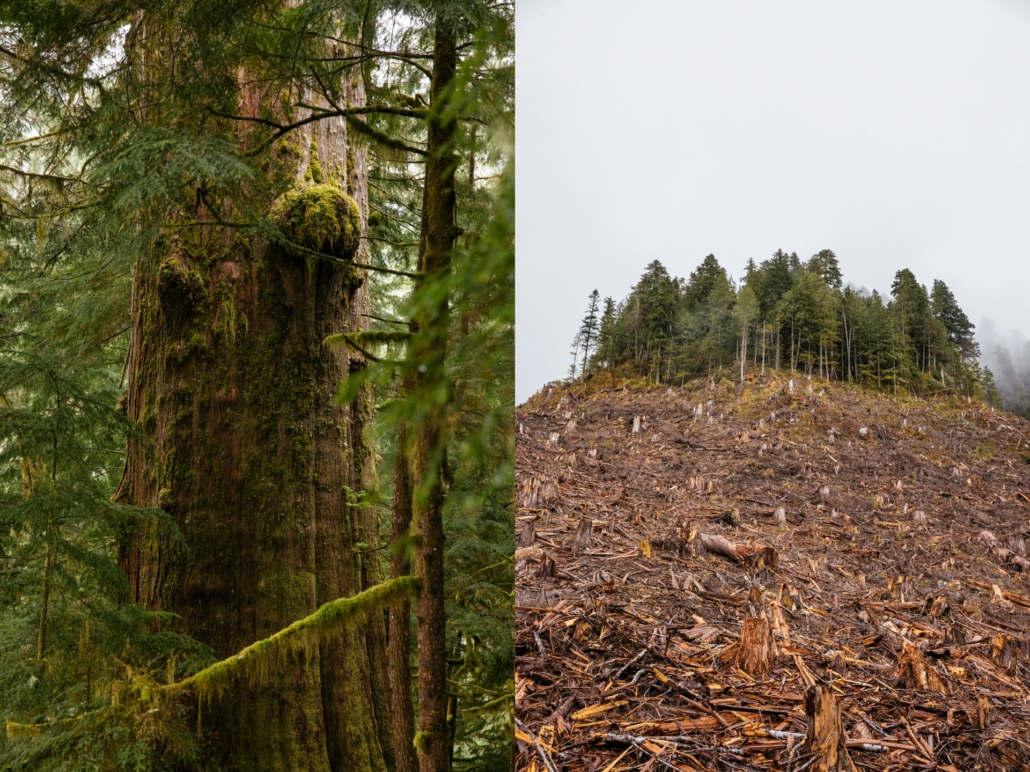
1. Work with Indigenous governments to immediately halt logging in BC’s most at-risk old-growth forests, as recommended by the independent panel.
2. Implement all of the Old Growth Strategic Review panel’s recommendations within the proposed three-year timeline.
3. Allocate funding to support Indigenous-led protected areas, land-use planning, and economic alternatives to old-growth logging.
4. Create a provincial land acquisition fund to purchase and protect endangered ecosystems on private lands.
5. Develop a strategy to support the transition to a sustainable, value-added, second-growth forest sector.
6. Enact legislation that places ecosystem integrity, biodiversity, and ecosystem services over timber values.
Read the original article
Receive campaign updates, old-growth photo galleries, news about AFA events, ways to take action, and more!
